- GCN/BACODINE POSITION NOTICE
TITLE: GCN/SWIFT NOTICE
NOTICE_DATE: Sat 19 Jun 21 23:59:38 UT
NOTICE_TYPE: Swift-BAT GRB Position
TRIGGER_NUM: 1056757, Seg_Num: 0
GRB_RA: 319.713d {+21h 18m 51s} (J2000),
319.936d {+21h 19m 45s} (current),
319.193d {+21h 16m 46s} (1950)
GRB_DEC: +33.860d {+33d 51' 35"} (J2000),
+33.951d {+33d 57' 04"} (current),
+33.648d {+33d 38' 54"} (1950)
GRB_ERROR: 3.00 [arcmin radius, statistical only]
GRB_INTEN: 1120 [cnts] Image_Peak=81 [image_cnts]
TRIGGER_DUR: 0.064 [sec]
TRIGGER_INDEX: 10427 E_range: 50-350 keV
BKG_INTEN: 23513 [cnts]
BKG_TIME: 86348.77 SOD {23:59:08.77} UT
BKG_DUR: 8 [sec]
GRB_DATE: 19384 TJD; 170 DOY; 21/06/19
GRB_TIME: 86365.41 SOD {23:59:25.41} UT
GRB_PHI: -58.55 [deg]
GRB_THETA: 35.87 [deg]
SOLN_STATUS: 0x3
RATE_SIGNIF: 67.02 [sigma]
IMAGE_SIGNIF: 8.13 [sigma]
MERIT_PARAMS: +1 +0 +0 -4 +3 -2 +0 +0 +25 +0
SUN_POSTN: 88.81d {+05h 55m 15s} +23.43d {+23d 25' 53"}
SUN_DIST: 104.81 [deg] Sun_angle= 8.6 [hr] (West of Sun)
MOON_POSTN: 202.55d {+13h 30m 13s} -5.36d {-05d 21' 18"}
MOON_DIST: 115.59 [deg]
MOON_ILLUM: 70 [%]
GAL_COORDS: 80.35,-10.91 [deg] galactic lon,lat of the burst (or transient)
ECL_COORDS: 336.84, 46.45 [deg] ecliptic lon,lat of the burst (or transient)
COMMENTS: SWIFT-BAT GRB Coordinates.
COMMENTS: This is a rate trigger.
COMMENTS: A point_source was found.
COMMENTS: This does not match any source in the on-board catalog.
COMMENTS: This does not match any source in the ground catalog.
COMMENTS: This is a GRB.
COMMENTS: This trigger occurred at longitude,latitude = 31.38,-11.06 [deg].
- red DSS finding chart
ps-file
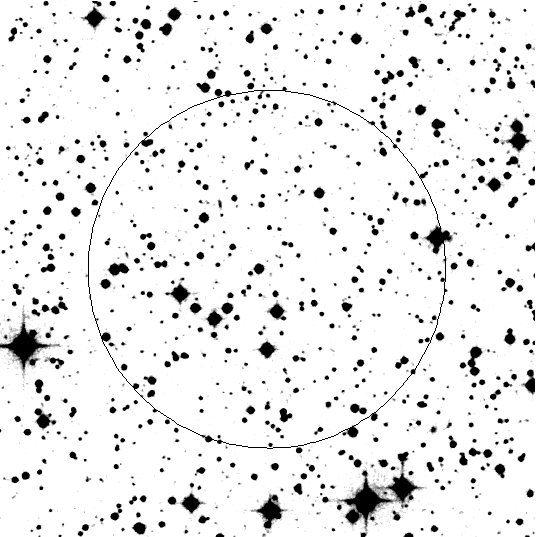
- GCN NOTICE
TITLE: GCN/SWIFT NOTICE
NOTICE_DATE: Sun 20 Jun 21 00:03:26 UT
NOTICE_TYPE: Swift-BAT GRB Lightcurve
TRIGGER_NUM: 1056757, Seg_Num: 0
GRB_RA: 319.713d {+21h 18m 51s} (J2000),
319.936d {+21h 19m 45s} (current),
319.193d {+21h 16m 46s} (1950)
GRB_DEC: +33.860d {+33d 51' 35"} (J2000),
+33.951d {+33d 57' 04"} (current),
+33.648d {+33d 38' 54"} (1950)
GRB_DATE: 19384 TJD; 170 DOY; 21/06/19
GRB_TIME: 86365.66 SOD {23:59:25.66} UT
TRIGGER_INDEX: 10427
GRB_PHI: -58.55 [deg]
GRB_THETA: 35.87 [deg]
DELTA_TIME: 71.00 [sec]
TRIGGER_DUR: 0.064 [sec]
SOLN_STATUS: 0x3
RATE_SIGNIF: 67.02 [sigma]
IMAGE_SIGNIF: 8.13 [sigma]
LC_URL: sw01056757000msb.lc
SUN_POSTN: 88.81d {+05h 55m 15s} +23.43d {+23d 25' 53"}
SUN_DIST: 104.81 [deg] Sun_angle= 8.6 [hr] (West of Sun)
MOON_POSTN: 202.59d {+13h 30m 21s} -5.37d {-05d 22' 16"}
MOON_DIST: 115.58 [deg]
MOON_ILLUM: 70 [%]
GAL_COORDS: 80.35,-10.91 [deg] galactic lon,lat of the burst (or transient)
ECL_COORDS: 336.84, 46.45 [deg] ecliptic lon,lat of the burst (or transient)
COMMENTS: SWIFT-BAT GRB Lightcurve.
COMMENTS:
COMMENTS: The next comments were copied from the BAT_POS Notice:
COMMENTS: This is a rate trigger.
COMMENTS: A point_source was found.
COMMENTS: This does not match any source in the on-board catalog.
COMMENTS: This does not match any source in the ground catalog.
COMMENTS: This is a GRB.
COMMENTS: This trigger occurred at longitude,latitude = 31.38,-11.06 [deg].
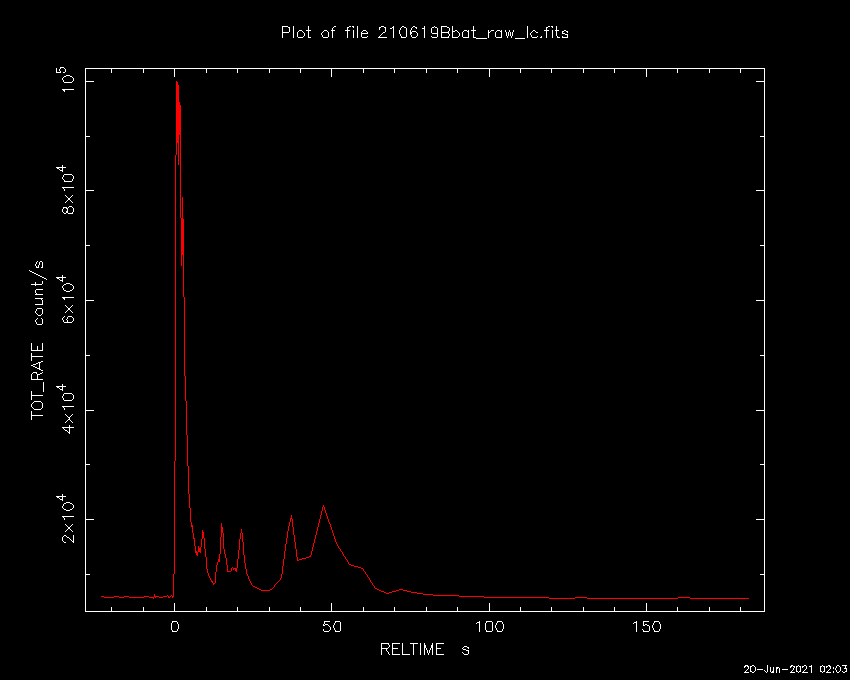
- GCN Notice
TITLE: GCN/SWIFT NOTICE
NOTICE_DATE: Sun 20 Jun 21 00:04:35 UT
NOTICE_TYPE: Swift-UVOT Source List
TRIGGER_NUM: 1056757, Seg_Num: 0
POINT_RA: 319.685d {+21h 18m 44s} (J2000)
POINT_DEC: +33.840d {+33d 50' 23"} (J2000)
POINT_ROLL: 47.461d
IMG_START_DATE: 19385 TJD; 171 DOY; 21/06/20
IMG_START_TIME: 100.92 SOD {00:01:40.92} UT, 135.5 [sec] since BAT Trigger Time
FILTER: 10, White
BKG_MEAN: 2.194
N_STARS: 190
X_OFFSET: 690 [pixels]
Y_OFFSET: 457 [pixels]
X_MAX: 1649 [pixels]
Y_MAX: 1416 [pixels]
DET_THRESH: 12
PHOTO_THRESH: 6
SL_URL: sw01056757000msufc0135.fits
SUN_POSTN: 88.82d {+05h 55m 16s} +23.43d {+23d 25' 53"}
SUN_DIST: 104.84 [deg] Sun_angle= 8.6 [hr] (West of Sun)
MOON_POSTN: 202.60d {+13h 30m 23s} -5.38d {-05d 22' 34"}
MOON_DIST: 115.55 [deg]
MOON_ILLUM: 70 [%]
GAL_COORDS: 80.32,-10.90 [deg] galactic lon,lat of the pointing direction
ECL_COORDS: 336.79, 46.44 [deg] ecliptic lon,lat of the pointing direction
COMMENTS: SWIFT-UVOT Source List.
- red DSS finding chart
ps-file

- GCN NOTICE
TITLE: GCN/SWIFT NOTICE
NOTICE_DATE: Sun 20 Jun 21 00:04:49 UT
NOTICE_TYPE: Swift-UVOT Processed Source List
TRIGGER_NUM: 1056757, Seg_Num: 0
POINT_RA: 319.685d {+21h 18m 44s} (J2000)
POINT_DEC: +33.840d {+33d 50' 23"} (J2000)
POINT_ROLL: 47.461d
IMG_START_DATE: 19385 TJD; 171 DOY; 21/06/20
IMG_START_TIME: 100.92 SOD {00:01:40.92} UT, 135.5 [sec] since BAT Trigger Time
FILTER: 10, White
BKG_MEAN: 2.194
N_STARS: 190
X_OFFSET: 690 [pixels]
Y_OFFSET: 457 [pixels]
X_MAX: 1649 [pixels]
Y_MAX: 1416 [pixels]
DET_THRESH: 12
PHOTO_THRESH: 6
SL_URL: sw01056757000msufc0135.fits
SUN_POSTN: 88.82d {+05h 55m 16s} +23.43d {+23d 25' 53"}
SUN_DIST: 104.84 [deg] Sun_angle= 8.6 [hr] (West of Sun)
MOON_POSTN: 202.60d {+13h 30m 24s} -5.38d {-05d 22' 37"}
MOON_DIST: 115.55 [deg]
MOON_ILLUM: 70 [%]
GAL_COORDS: 80.32,-10.90 [deg] galactic lon,lat of the pointing direction
ECL_COORDS: 336.79, 46.44 [deg] ecliptic lon,lat of the pointing direction
COMMENTS: SWIFT-UVOT Processed Source List.
COMMENTS: All 4 attachments are included.
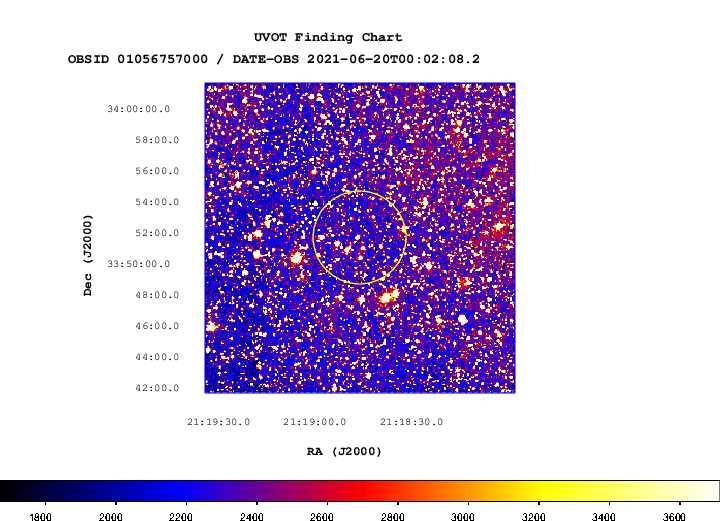
- GCN NOTICE
TITLE: GCN/SWIFT NOTICE
NOTICE_DATE: Sun 20 Jun 21 00:06:01 UT
NOTICE_TYPE: Swift-UVOT Image
TRIGGER_NUM: 1056757, Seg_Num: 0
POINT_RA: 319.685d {+21h 18m 44s} (J2000)
POINT_DEC: +33.840d {+33d 50' 23"} (J2000)
ROLL: 47.461d
IMG_START_DATE: 19385 TJD; 171 DOY; 21/06/20
IMG_START_TIME: 100.92 SOD {00:01:40.92} UT, 135.5 [sec] since BAT Trigger Time
FILTER: 10, White
EXPOSURE_ID: 645840128
X_OFFSET: 1009 [pixels]
Y_OFFSET: 776 [pixels]
WIDTH: 160 [pixels]
HEIGHT: 160 [pixels]
X_GRB_POS: 1169
Y_GRB_POS: 936
BINNING_INDEX: 1
IM_URL: sw01056757000msuni0163.fits
SUN_POSTN: 88.82d {+05h 55m 16s} +23.43d {+23d 25' 53"}
SUN_DIST: 104.84 [deg] Sun_angle= 8.6 [hr] (West of Sun)
MOON_POSTN: 202.61d {+13h 30m 27s} -5.38d {-05d 22' 55"}
MOON_DIST: 115.54 [deg]
MOON_ILLUM: 70 [%]
GAL_COORDS: 80.32,-10.90 [deg] galactic lon,lat of the pointing direction
ECL_COORDS: 336.79, 46.44 [deg] ecliptic lon,lat of the pointing direction
COMMENTS: SWIFT-UVOT Image.
COMMENTS: The GRB Position came from the Window Position in the Mode Command.
COMMENTS: The image has 2x2 binning (compression).
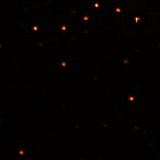
- GCN NOTICE
TITLE: GCN/SWIFT NOTICE
NOTICE_DATE: Sun 20 Jun 21 00:06:41 UT
NOTICE_TYPE: Swift-XRT Image
TRIGGER_NUM: 1056757, Seg_Num: 0
GRB_RA: 319.7161d {+21h 18m 51.8s} (J2000),
319.9394d {+21h 19m 45.4s} (current),
319.1965d {+21h 16m 47.1s} (1950)
GRB_DEC: +33.8495d {+33d 50' 58.1"} (J2000),
+33.9408d {+33d 56' 26.9"} (current),
+33.6379d {+33d 38' 16.5"} (1950)
GRB_ERROR: 4.7 [arcsec, radius, statistical plus systematic]
GRB_INTEN: 132 [cnts]
IMG_START_DATE: 19385 TJD; 171 DOY; 21/06/20
IMG_START_TIME: 293.45 SOD {00:04:53.45} UT, 328.0 [sec] since BAT Trigger Time
CENTROID_X: 265.72, raw= 266 [pixels]
CENTROID_Y: 280.44, raw= 280 [pixels]
ROLL: 47.46 [deg]
GAIN: 2
MODE: 3, Long Image mode
WAVEFORM: 134
EXPO_TIME: 2.50 [sec]
GRB_POS_XRT_Y: -41.61
GRB_POS_XRT_Z: -98.22
IMAGE_URL: sw01056757000msxps_rw.img
SUN_POSTN: 88.82d {+05h 55m 16s} +23.43d {+23d 25' 53"}
SUN_DIST: 104.82 [deg] Sun_angle= 8.6 [hr] (West of Sun)
MOON_POSTN: 202.62d {+13h 30m 28s} -5.39d {-05d 23' 06"}
MOON_DIST: 115.56 [deg]
MOON_ILLUM: 70 [%]
GAL_COORDS: 80.34,-10.92 [deg] galactic lon,lat of the burst
ECL_COORDS: 336.83, 46.44 [deg] ecliptic lon,lat of the burst
COMMENTS: SWIFT-XRT Image.
COMMENTS: The object found at this position is either a very bright burst or a cosmic ray hit.
COMMENTS: Examine the XRT Image to differentiate (CRs are much more compact); see examples at:
COMMENTS: http://www.swift.psu.edu/xrt/XRT_Postage_Stamp_Image_Photo_Gallery.htm .

- GCN NOTICE
TITLE: GCN/SWIFT NOTICE
NOTICE_DATE: Sun 20 Jun 21 00:06:43 UT
NOTICE_TYPE: Swift-XRT Processed Image
TRIGGER_NUM: 1056757, Seg_Num: 0
GRB_RA: 319.7161d {+21h 18m 51.8s} (J2000),
319.9394d {+21h 19m 45.4s} (current),
319.1965d {+21h 16m 47.1s} (1950)
GRB_DEC: +33.8495d {+33d 50' 58.1"} (J2000),
+33.9408d {+33d 56' 26.9"} (current),
+33.6379d {+33d 38' 16.5"} (1950)
GRB_ERROR: 4.7 [arcsec, radius, statistical plus systematic]
GRB_INTEN: 132 [cnts]
IMG_START_DATE: 19385 TJD; 171 DOY; 21/06/20
IMG_START_TIME: 293.45 SOD {00:04:53.45} UT, 328.0 [sec] since BAT Trigger Time
CENTROID_X: 265.72, raw= 266 [pixels]
CENTROID_Y: 280.44, raw= 280 [pixels]
ROLL: 47.46 [deg]
GAIN: 2
MODE: 3, Long Image mode
WAVEFORM: 134
EXPO_TIME: 2.50 [sec]
GRB_POS_XRT_Y: -41.61
GRB_POS_XRT_Z: -98.22
IMAGE_URL: sw01056757000msxps_rw.img
SUN_POSTN: 88.82d {+05h 55m 16s} +23.43d {+23d 25' 53"}
SUN_DIST: 104.82 [deg] Sun_angle= 8.6 [hr] (West of Sun)
MOON_POSTN: 202.62d {+13h 30m 28s} -5.39d {-05d 23' 06"}
MOON_DIST: 115.56 [deg]
MOON_ILLUM: 70 [%]
GAL_COORDS: 80.34,-10.92 [deg] galactic lon,lat of the burst
ECL_COORDS: 336.83, 46.44 [deg] ecliptic lon,lat of the burst
COMMENTS: SWIFT-XRT Processed Image.
COMMENTS: The object found at this position is either a very bright burst or a cosmic ray hit.
COMMENTS: Examine the XRT Image to differentiate (CRs are much more compact); see examples at:
COMMENTS: http://www.swift.psu.edu/xrt/XRT_Postage_Stamp_Image_Photo_Gallery.htm .

- GCN NOTICE
TITLE: GCN/SWIFT NOTICE
NOTICE_DATE: Sun 20 Jun 21 00:06:16 UT
NOTICE_TYPE: Swift-UVOT Processed Image
TRIGGER_NUM: 1056757, Seg_Num: 0
POINT_RA: 319.685d {+21h 18m 44s} (J2000)
POINT_DEC: +33.840d {+33d 50' 23"} (J2000)
ROLL: 47.461d
IMG_START_DATE: 19385 TJD; 171 DOY; 21/06/20
IMG_START_TIME: 100.92 SOD {00:01:40.92} UT, 135.5 [sec] since BAT Trigger Time
FILTER: 10, White
EXPOSURE_ID: 645840128
X_OFFSET: 1009 [pixels]
Y_OFFSET: 776 [pixels]
WIDTH: 160 [pixels]
HEIGHT: 160 [pixels]
X_GRB_POS: 1169
Y_GRB_POS: 936
BINNING_INDEX: 1
IM_URL: sw01056757000msuni0163.fits
SUN_POSTN: 88.82d {+05h 55m 16s} +23.43d {+23d 25' 53"}
SUN_DIST: 104.84 [deg] Sun_angle= 8.6 [hr] (West of Sun)
MOON_POSTN: 202.61d {+13h 30m 27s} -5.38d {-05d 23' 00"}
MOON_DIST: 115.54 [deg]
MOON_ILLUM: 70 [%]
GAL_COORDS: 80.32,-10.90 [deg] galactic lon,lat of the pointing direction
ECL_COORDS: 336.79, 46.44 [deg] ecliptic lon,lat of the pointing direction
COMMENTS: SWIFT-UVOT Processed Image.
COMMENTS: The GRB Position came from the Window Position in the Mode Command.
COMMENTS: The image has 2x2 binning (compression).
COMMENTS: All 4 attachments are included.
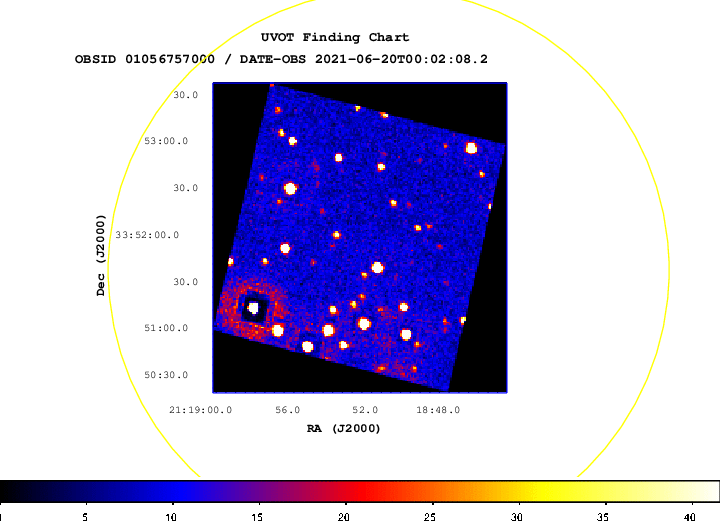
- GCN NOTICE
TITLE: GCN/SWIFT NOTICE
NOTICE_DATE: Sun 20 Jun 21 00:06:31 UT
NOTICE_TYPE: Swift-XRT Position
TRIGGER_NUM: 1056757, Seg_Num: 0
GRB_RA: 319.7161d {+21h 18m 51.86s} (J2000),
319.9394d {+21h 19m 45.44s} (current),
319.1965d {+21h 16m 47.15s} (1950)
GRB_DEC: +33.8495d {+33d 50' 58.1"} (J2000),
+33.9408d {+33d 56' 26.9"} (current),
+33.6379d {+33d 38' 16.5"} (1950)
GRB_ERROR: 4.9 [arcsec radius, statistical plus systematic, 90% containment]
GRB_INTEN: 4.27e-09 [erg/cm2/sec]
GRB_SIGNIF: 11.48 [sigma]
IMG_START_DATE: 19385 TJD; 171 DOY; 21/06/20
IMG_START_TIME: 293.45 SOD {00:04:53.45} UT, 328.0 [sec] since BAT Trigger Time
TAM[0-3]: 327.66 237.20 261.66 243.74
AMPLIFIER: 2
WAVEFORM: 134
SUN_POSTN: 88.82d {+05h 55m 16s} +23.43d {+23d 25' 53"}
SUN_DIST: 104.82 [deg] Sun_angle= 8.6 [hr] (West of Sun)
MOON_POSTN: 202.61d {+13h 30m 28s} -5.38d {-05d 23' 03"}
MOON_DIST: 115.56 [deg]
MOON_ILLUM: 70 [%]
GAL_COORDS: 80.34,-10.92 [deg] galactic lon,lat of the burst
ECL_COORDS: 336.83, 46.44 [deg] ecliptic lon,lat of the burst
COMMENTS: SWIFT-XRT Coordinates.
COMMENTS: The XRT position is 0.64 arcmin from the BAT position.
COMMENTS: The object found at this position is either a very bright burst or a cosmic ray hit.
COMMENTS: Examine the XRT Image to differentiate (CRs are much more compact); see examples at:
COMMENTS: http://www.swift.psu.edu/xrt/XRT_Postage_Stamp_Image_Photo_Gallery.htm .
- GCN Circular #30259
V. Lipunov, E. Gorbovskoy, V.Kornilov, D.Kuvshinov, N.Tyurina, P.Balanutsa,
A.Kuznetsov, D. Vlasenko, F. Balakin, I. Gorbunov
Lomonosov Moscow State University,
Sternberg Astronomical Institute, Moscow State University
D. Buckley, S. Potter, A. Kniazev, M. Kotze
South African Astronomical Observatory
K. Ivanov, O. Gres, N.M. Budnev, S. Yazev, O. Chuvalaev, V. Poleshchuk
Irkutsk State University
A. Tlatov, V.Senik, A.V. Parhomenko, D. Dormidontov
Kislovodsk Solar Station of the Pulkovo Observatory
V. Yurkov, A. Gabovich, Yu. Sergienko
Blagoveschensk Educational State University, Blagoveschensk
R. Podesta, Carlos Lopez and F. Podesta
Observatorio Astronomico Felix Aguilar (OAFA)
R. Rebolo, M. Serra, N. Lodieu, G. Israelian, L. Suarez-Andres
The Instituto de Astrofisica de Canarias
MASTER-SAAO robotic telescope (Global MASTER-Net: http://observ.pereplet.ru, Lipunov et al., 2010, Advances in Astronomy, vol. 2010, 30L) located in South Africa (South African Astronomical Observatory) was pointed to the GRB210619.99 22 sec after notice time and 36 sec after trigger time at 2021-06-20 00:00:02 UT. On our first (10s exposure) set we found 1 optical transient within Swift error-box (ra=319.708 dec=33.86 r=0.05) brighter than 15.3.
T-Tmid Date Time Expt. Ra Dec Mag
---------|---------------------|-------|-----------------|-----------------|-------
41 2021-06-20 00:00:02 10 (21h 18m 52.35s , +33d 51m 01.4s) 10.4
The 5-sigma upper limit has been about 15.3mag
The message may be cited.
- GCN NOTICE
TITLE: GCN/SWIFT NOTICE
NOTICE_DATE: Sun 20 Jun 21 00:09:05 UT
NOTICE_TYPE: Swift-UVOT Position
TRIGGER_NUM: 1056757, Seg_Num: 0
GRB_RA: 319.7183d {+21h 18m 52.39s} (J2000),
319.9416d {+21h 19m 45.97s} (current),
319.1987d {+21h 16m 47.68s} (1950)
GRB_DEC: +33.8504d {+33d 51' 01.4"} (J2000),
+33.9417d {+33d 56' 30.1"} (current),
+33.6388d {+33d 38' 19.7"} (1950)
GRB_ERROR: 0.6 [arcsec radius, statistical only]
GRB_MAG: 14.71 +/- 0.14 [mag]
FILTER: 10, White
IMG_START_DATE: 19385 TJD; 171 DOY; 21/06/20
IMG_START_TIME: 97.00 SOD {00:01:37.00} UT, 131.6 [sec] since BAT Trigger Time
SUN_POSTN: 88.82d {+05h 55m 16s} +23.43d {+23d 25' 53"}
SUN_DIST: 104.82 [deg] Sun_angle= 8.6 [hr] (West of Sun)
MOON_POSTN: 202.64d {+13h 30m 33s} -5.40d {-05d 23' 42"}
MOON_DIST: 115.55 [deg]
MOON_ILLUM: 70 [%]
GAL_COORDS: 80.34,-10.92 [deg] galactic lon,lat of the burst (or transient)
ECL_COORDS: 336.84, 46.44 [deg] ecliptic lon,lat of the burst (or transient)
COMMENTS: SWIFT UVOT Position Notice.
COMMENTS: This Notice was ground-generated -- not flight-generated.
COMMENTS: The UVOT position is 6.8 arcsec from the XRT position.
COMMENTS: Result based on Genie data.
COMMENTS: Notice generated automatically.
- GCN NOTICE
TITLE: GCN/SWIFT NOTICE
NOTICE_DATE: Sun 20 Jun 21 00:11:41 UT
NOTICE_TYPE: Swift-UVOT Source List
TRIGGER_NUM: 1056757, Seg_Num: 0
POINT_RA: 319.682d {+21h 18m 44s} (J2000)
POINT_DEC: +33.840d {+33d 50' 23"} (J2000)
POINT_ROLL: 47.457d
IMG_START_DATE: 19385 TJD; 171 DOY; 21/06/20
IMG_START_TIME: 313.29 SOD {00:05:13.29} UT, 347.9 [sec] since BAT Trigger Time
FILTER: 7, U
BKG_MEAN: 0.693
N_STARS: 190
X_OFFSET: 450 [pixels]
Y_OFFSET: 217 [pixels]
X_MAX: 1889 [pixels]
Y_MAX: 1656 [pixels]
DET_THRESH: 7
PHOTO_THRESH: 3
SL_URL: sw01056757000msufc0347.fits
SUN_POSTN: 88.82d {+05h 55m 17s} +23.43d {+23d 25' 53"}
SUN_DIST: 104.85 [deg] Sun_angle= 8.6 [hr] (West of Sun)
MOON_POSTN: 202.66d {+13h 30m 39s} -5.41d {-05d 24' 22"}
MOON_DIST: 115.51 [deg]
MOON_ILLUM: 70 [%]
GAL_COORDS: 80.31,-10.90 [deg] galactic lon,lat of the pointing direction
ECL_COORDS: 336.79, 46.44 [deg] ecliptic lon,lat of the pointing direction
COMMENTS: SWIFT-UVOT Source List.
- GCN Circular #30260
V. Lipunov, E. Gorbovskoy, V.Kornilov, N.Tyurina, P.Balanutsa, A.Kuznetsov, F.Balakin,
V.Vladimirov, D. Vlasenko, I.Gorbunov, D.Zimnukhov, V.Senik, T.Pogrosheva,
D.Kuvshinov, D. Cheryasov
(Lomonosov Moscow State University, SAI, Physics Department),
R. Podesta, C.Lopez, F. Podesta, C.Francile
(Observatorio Astronomico Felix Aguilar OAFA),
R. Rebolo, M. Serra
(The Instituto de Astrofisica de Canarias),
D. Buckley
(South African Astronomical Observatory),
O.A. Gres, N.M. Budnev, O.Ershova
(Irkutsk State University, API),
A. Tlatov, D. Dormidontov
(Kislovodsk Solar Station of the Pulkovo Observatory),
V. Yurkov, A. Gabovich, Yu. Sergienko
(Blagoveschensk Educational State University)
MASTER-SAAO robotic telescope (Global MASTER-Net: http://observ.pereplet.ru, Lipunov et al., 2010, Advances in Astronomy, vol. 2010, 30L) located in South Africa (South African Astronomical Observatory) was pointed to the Swift GRB210619.99 (trigger No 1056757,21h 18m 51.12s , +33d 51m 36.0s, R=0.05) errorbox 0 sec after notice time and 36 sec after trigger time at 2021-06-20 00:00:02 UT, with upper limit up to 16.7 mag. The observations began at zenith distance = 72 deg. The sun altitude is -70.4 deg.
The galactic latitude b = -11 deg., longitude l = 81 deg.
Real time updated cover map and OT discovered available here:
https://master.sai.msu.ru/site/master2/observ.php?id=1640637
We obtain a following upper limits.
Tmid-T0 | Site |Filt.| Expt. | Limit| Comment
_________|_____________________|_____|_______|______|________
42 | MASTER-SAAO | P\ | 10 | 15.8 |
57 | MASTER-SAAO | P\ | 40 | 16.5 | Coadd
71 | MASTER-SAAO | P\ | 10 | 15.6 |
106 | MASTER-SAAO | P\ | 20 | 16.2 |
150 | MASTER-SAAO | P\ | 30 | 16.5 |
205 | MASTER-SAAO | P\ | 40 | 16.4 |
269 | MASTER-SAAO | P\ | 50 | 16.7 |
344 | MASTER-SAAO | P\ | 60 | 16.7 |
The observation and reduction will continue.
The message may be cited.
- GCN NOTICE
TITLE: GCN/SWIFT NOTICE
NOTICE_DATE: Sun 20 Jun 21 00:11:54 UT
NOTICE_TYPE: Swift-UVOT Processed Source List
TRIGGER_NUM: 1056757, Seg_Num: 0
POINT_RA: 319.682d {+21h 18m 44s} (J2000)
POINT_DEC: +33.840d {+33d 50' 23"} (J2000)
POINT_ROLL: 47.457d
IMG_START_DATE: 19385 TJD; 171 DOY; 21/06/20
IMG_START_TIME: 313.29 SOD {00:05:13.29} UT, 347.9 [sec] since BAT Trigger Time
FILTER: 7, U
BKG_MEAN: 0.693
N_STARS: 190
X_OFFSET: 450 [pixels]
Y_OFFSET: 217 [pixels]
X_MAX: 1889 [pixels]
Y_MAX: 1656 [pixels]
DET_THRESH: 7
PHOTO_THRESH: 3
SL_URL: sw01056757000msufc0347.fits
SUN_POSTN: 88.82d {+05h 55m 17s} +23.43d {+23d 25' 53"}
SUN_DIST: 104.85 [deg] Sun_angle= 8.6 [hr] (West of Sun)
MOON_POSTN: 202.66d {+13h 30m 39s} -5.41d {-05d 24' 26"}
MOON_DIST: 115.51 [deg]
MOON_ILLUM: 70 [%]
GAL_COORDS: 80.31,-10.90 [deg] galactic lon,lat of the pointing direction
ECL_COORDS: 336.79, 46.44 [deg] ecliptic lon,lat of the pointing direction
COMMENTS: SWIFT-UVOT Processed Source List.
COMMENTS: All 4 attachments are included.
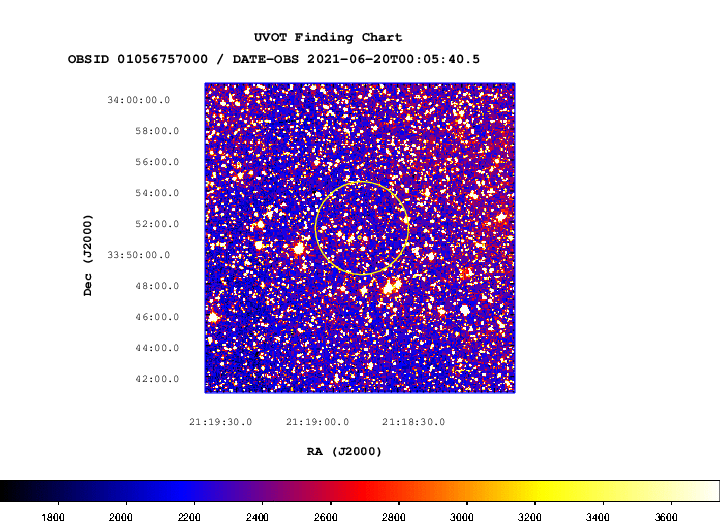
- GCN NOTICE
TITLE: GCN/SWIFT NOTICE
NOTICE_DATE: Sun 20 Jun 21 00:13:04 UT
NOTICE_TYPE: Swift-UVOT Image
TRIGGER_NUM: 1056757, Seg_Num: 0
POINT_RA: 319.682d {+21h 18m 44s} (J2000)
POINT_DEC: +33.840d {+33d 50' 23"} (J2000)
ROLL: 47.457d
IMG_START_DATE: 19385 TJD; 171 DOY; 21/06/20
IMG_START_TIME: 313.29 SOD {00:05:13.29} UT, 347.9 [sec] since BAT Trigger Time
FILTER: 7, U
EXPOSURE_ID: 645840340
X_OFFSET: 1009 [pixels]
Y_OFFSET: 776 [pixels]
WIDTH: 160 [pixels]
HEIGHT: 160 [pixels]
X_GRB_POS: 1169
Y_GRB_POS: 936
BINNING_INDEX: 1
IM_URL: sw01056757000msuni0375.fits
SUN_POSTN: 88.82d {+05h 55m 17s} +23.43d {+23d 25' 53"}
SUN_DIST: 104.85 [deg] Sun_angle= 8.6 [hr] (West of Sun)
MOON_POSTN: 202.67d {+13h 30m 42s} -5.41d {-05d 24' 43"}
MOON_DIST: 115.51 [deg]
MOON_ILLUM: 70 [%]
GAL_COORDS: 80.31,-10.90 [deg] galactic lon,lat of the pointing direction
ECL_COORDS: 336.79, 46.44 [deg] ecliptic lon,lat of the pointing direction
COMMENTS: SWIFT-UVOT Image.
COMMENTS: The GRB Position came from the Window Position in the Mode Command.
COMMENTS: The image has 2x2 binning (compression).
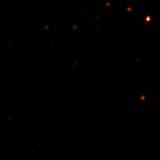
- GCN NOTICE
TITLE: GCN/SWIFT NOTICE
NOTICE_DATE: Sun 20 Jun 21 00:13:11 UT
NOTICE_TYPE: Swift-UVOT Processed Image
TRIGGER_NUM: 1056757, Seg_Num: 0
POINT_RA: 319.682d {+21h 18m 44s} (J2000)
POINT_DEC: +33.840d {+33d 50' 23"} (J2000)
ROLL: 47.457d
IMG_START_DATE: 19385 TJD; 171 DOY; 21/06/20
IMG_START_TIME: 313.29 SOD {00:05:13.29} UT, 347.9 [sec] since BAT Trigger Time
FILTER: 7, U
EXPOSURE_ID: 645840340
X_OFFSET: 1009 [pixels]
Y_OFFSET: 776 [pixels]
WIDTH: 160 [pixels]
HEIGHT: 160 [pixels]
X_GRB_POS: 1169
Y_GRB_POS: 936
BINNING_INDEX: 1
IM_URL: sw01056757000msuni0375.fits
SUN_POSTN: 88.82d {+05h 55m 17s} +23.43d {+23d 25' 53"}
SUN_DIST: 104.85 [deg] Sun_angle= 8.6 [hr] (West of Sun)
MOON_POSTN: 202.68d {+13h 30m 42s} -5.41d {-05d 24' 45"}
MOON_DIST: 115.51 [deg]
MOON_ILLUM: 70 [%]
GAL_COORDS: 80.31,-10.90 [deg] galactic lon,lat of the pointing direction
ECL_COORDS: 336.79, 46.44 [deg] ecliptic lon,lat of the pointing direction
COMMENTS: SWIFT-UVOT Processed Image.
COMMENTS: The GRB Position came from the Window Position in the Mode Command.
COMMENTS: The image has 2x2 binning (compression).
COMMENTS: All 4 attachments are included.
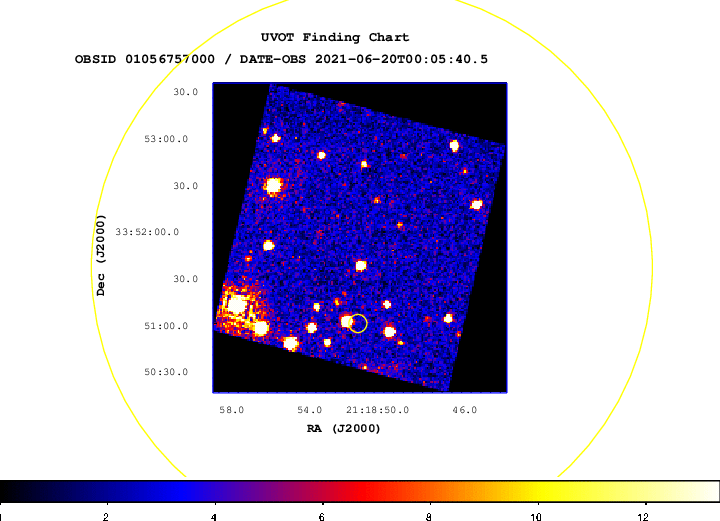
- GCN Circular #30261
P. D'Avanzo (INAF-OAB), M. G. Bernardini (INAF-OAB),
A. Y. Lien (GSFC/UMBC), A. Melandri (INAF-OAB),
K. L. Page (U Leicester), D. M. Palmer (LANL) and
T. Sbarrato (INAF-OAB) report on behalf of the Neil Gehrels Swift
Observatory Team:
At 23:59:25 UT, the Swift Burst Alert Telescope (BAT) triggered and
located GRB 210619B (trigger=1056757). Swift slewed immediately to the burst.
The BAT on-board calculated location is
RA, Dec 319.713, +33.860 which is
RA(J2000) = 21h 18m 51s
Dec(J2000) = +33d 51' 35"
with an uncertainty of 3 arcmin (radius, 90% containment, including
systematic uncertainty). The BAT light curve showed a complex
structure with a duration of about 100 sec. The peak count rate
was ~100,000 counts/sec (15-350 keV), at ~0 sec after the trigger.
The XRT began observing the field at 00:04:53.4 UT, 328.1 seconds after
the BAT trigger. XRT found a bright, uncatalogued X-ray source located
at RA, Dec 319.7161, 33.8495 which is equivalent to:
RA(J2000) = 21h 18m 51.86s
Dec(J2000) = +33d 50' 58.2"
with an uncertainty of 11.1 arcseconds (radius, 90% containment). This
location is 38 arcseconds from the BAT onboard position, within the BAT
error circle. No event data are yet available to determine the column
density using X-ray spectroscopy.
The initial flux in the 2.5 s image was 4.27e-09 erg cm^-2 s^-1 (0.2-10
keV).
UVOT took a finding chart exposure of 150 seconds with the White filter
starting 135 seconds after the BAT trigger. There is a candidate afterglow in
the rapidly available 2.7'x2.7' sub-image at
RA(J2000) = 21:18:52.39 = 319.71831
DEC(J2000) = +33:51:01.6 = 33.85044
with a 90%-confidence error radius of about 0.61 arc sec. This position is 7.5
arc sec. from the center of the XRT error circle. The estimated magnitude is
14.71 with a 1-sigma error of about 0.14. No correction has been made for the
expected extinction corresponding to E(B-V) of 0.173.
Burst Advocate for this burst is P. D'Avanzo (paolo.davanzo AT inaf.it).
Please contact the BA by email if you require additional information
regarding Swift followup of this burst. In extremely urgent cases, after
trying the Burst Advocate, you can contact the Swift PI by phone (see
Swift TOO web site for information: http://www.swift.psu.edu/)
- GCN NOTICE
TITLE: GCN/SWIFT NOTICE
NOTICE_DATE: Sun 20 Jun 21 00:17:02 UT
NOTICE_TYPE: Swift-UVOT Processed Source List
TRIGGER_NUM: 1056757, Seg_Num: 0
POINT_RA: 319.682d {+21h 18m 44s} (J2000)
POINT_DEC: +33.840d {+33d 50' 23"} (J2000)
POINT_ROLL: 47.457d
IMG_START_DATE: 19385 TJD; 171 DOY; 21/06/20
IMG_START_TIME: 823.17 SOD {00:13:43.17} UT, 857.8 [sec] since BAT Trigger Time
FILTER: 10, White
BKG_MEAN: 2.448
N_STARS: 190
X_OFFSET: 450 [pixels]
Y_OFFSET: 217 [pixels]
X_MAX: 1889 [pixels]
Y_MAX: 1656 [pixels]
DET_THRESH: 13
PHOTO_THRESH: 7
SL_URL: sw01056757000msufc0857.fits
SUN_POSTN: 88.82d {+05h 55m 18s} +23.43d {+23d 25' 53"}
SUN_DIST: 104.85 [deg] Sun_angle= 8.6 [hr] (West of Sun)
MOON_POSTN: 202.71d {+13h 30m 50s} -5.43d {-05d 25' 44"}
MOON_DIST: 115.49 [deg]
MOON_ILLUM: 70 [%]
GAL_COORDS: 80.31,-10.90 [deg] galactic lon,lat of the pointing direction
ECL_COORDS: 336.79, 46.44 [deg] ecliptic lon,lat of the pointing direction
COMMENTS: SWIFT-UVOT Processed Source List.
COMMENTS: All 4 attachments are included.

- GCN NOTICE
TITLE: GCN/SWIFT NOTICE
NOTICE_DATE: Sun 20 Jun 21 00:18:20 UT
NOTICE_TYPE: Swift-UVOT Image
TRIGGER_NUM: 1056757, Seg_Num: 0
POINT_RA: 319.682d {+21h 18m 44s} (J2000)
POINT_DEC: +33.840d {+33d 50' 23"} (J2000)
ROLL: 47.457d
IMG_START_DATE: 19385 TJD; 171 DOY; 21/06/20
IMG_START_TIME: 823.17 SOD {00:13:43.17} UT, 857.8 [sec] since BAT Trigger Time
FILTER: 10, White
EXPOSURE_ID: 645840850
X_OFFSET: 1009 [pixels]
Y_OFFSET: 776 [pixels]
WIDTH: 160 [pixels]
HEIGHT: 160 [pixels]
X_GRB_POS: 1169
Y_GRB_POS: 936
BINNING_INDEX: 1
IM_URL: sw01056757000msuni0885.fits
SUN_POSTN: 88.83d {+05h 55m 18s} +23.43d {+23d 25' 53"}
SUN_DIST: 104.85 [deg] Sun_angle= 8.6 [hr] (West of Sun)
MOON_POSTN: 202.72d {+13h 30m 53s} -5.43d {-05d 26' 04"}
MOON_DIST: 115.48 [deg]
MOON_ILLUM: 70 [%]
GAL_COORDS: 80.31,-10.90 [deg] galactic lon,lat of the pointing direction
ECL_COORDS: 336.79, 46.44 [deg] ecliptic lon,lat of the pointing direction
COMMENTS: SWIFT-UVOT Image.
COMMENTS: The GRB Position came from the Window Position in the Mode Command.
COMMENTS: The image has 2x2 binning (compression).
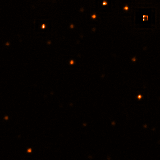
- GCN NOTICE
TITLE: GCN/SWIFT NOTICE
NOTICE_DATE: Sun 20 Jun 21 00:17:44 UT
NOTICE_TYPE: Swift-XRT Position UPDATE
TRIGGER_NUM: 1056757, Seg_Num: 0
GRB_RA: 319.7180d {+21h 18m 52.32s} (J2000),
319.9413d {+21h 19m 45.90s} (current),
319.1984d {+21h 16m 47.60s} (1950)
GRB_DEC: +33.8504d {+33d 51' 01.4"} (J2000),
+33.9417d {+33d 56' 30.1"} (current),
+33.6388d {+33d 38' 19.7"} (1950)
GRB_ERROR: 6.4 [arcsec radius, statistical plus systematic, 90% containment]
GRB_INTEN: 1.00e-10 [erg/cm2/sec]
GRB_SIGNIF: 10.00 [sigma]
IMG_START_DATE: 19385 TJD; 171 DOY; 21/06/20
IMG_START_TIME: 173.00 SOD {00:02:53.00} UT, 207.6 [sec] since BAT Trigger Time
TAM[0-3]: 100.00 100.00 100.00 100.00
AMPLIFIER: 1
WAVEFORM: 31
SUN_POSTN: 88.82d {+05h 55m 18s} +23.43d {+23d 25' 53"}
SUN_DIST: 104.82 [deg] Sun_angle= 8.6 [hr] (West of Sun)
MOON_POSTN: 202.72d {+13h 30m 52s} -5.43d {-05d 25' 55"}
MOON_DIST: 115.51 [deg]
MOON_ILLUM: 70 [%]
GAL_COORDS: 80.34,-10.92 [deg] galactic lon,lat of the burst
ECL_COORDS: 336.84, 46.44 [deg] ecliptic lon,lat of the burst
COMMENTS: SWIFT-XRT Coordinates.
COMMENTS: This Notice was ground-generated -- not flight-generated.
COMMENTS: This is an Update Notice -- the RA,Dec values herein supersede the previous XRT_POS Notice.
COMMENTS: TAM values, flux and significance fields are not valid.
COMMENTS: This position was automatically generated on the ground using
COMMENTS: Photon Counting data telemetered via TDRSS (SPER data).
COMMENTS: See http://www.swift.ac.uk/sper/docs.php for details.
COMMENTS: This position was enhanced using UVOT field astrometry.
COMMENTS: The probability that this is a serendipitous source in the
COMMENTS: SPER window is 0.11% < P(seren) < 0.58%.
- GCN NOTICE
TITLE: GCN/SWIFT NOTICE
NOTICE_DATE: Sun 20 Jun 21 00:18:30 UT
NOTICE_TYPE: Swift-UVOT Processed Image
TRIGGER_NUM: 1056757, Seg_Num: 0
POINT_RA: 319.682d {+21h 18m 44s} (J2000)
POINT_DEC: +33.840d {+33d 50' 23"} (J2000)
ROLL: 47.457d
IMG_START_DATE: 19385 TJD; 171 DOY; 21/06/20
IMG_START_TIME: 823.17 SOD {00:13:43.17} UT, 857.8 [sec] since BAT Trigger Time
FILTER: 10, White
EXPOSURE_ID: 645840850
X_OFFSET: 1009 [pixels]
Y_OFFSET: 776 [pixels]
WIDTH: 160 [pixels]
HEIGHT: 160 [pixels]
X_GRB_POS: 1169
Y_GRB_POS: 936
BINNING_INDEX: 1
IM_URL: sw01056757000msuni0885.fits
SUN_POSTN: 88.83d {+05h 55m 18s} +23.43d {+23d 25' 53"}
SUN_DIST: 104.85 [deg] Sun_angle= 8.6 [hr] (West of Sun)
MOON_POSTN: 202.72d {+13h 30m 54s} -5.44d {-05d 26' 07"}
MOON_DIST: 115.48 [deg]
MOON_ILLUM: 70 [%]
GAL_COORDS: 80.31,-10.90 [deg] galactic lon,lat of the pointing direction
ECL_COORDS: 336.79, 46.44 [deg] ecliptic lon,lat of the pointing direction
COMMENTS: SWIFT-UVOT Processed Image.
COMMENTS: The GRB Position came from the Window Position in the Mode Command.
COMMENTS: The image has 2x2 binning (compression).
COMMENTS: All 4 attachments are included.
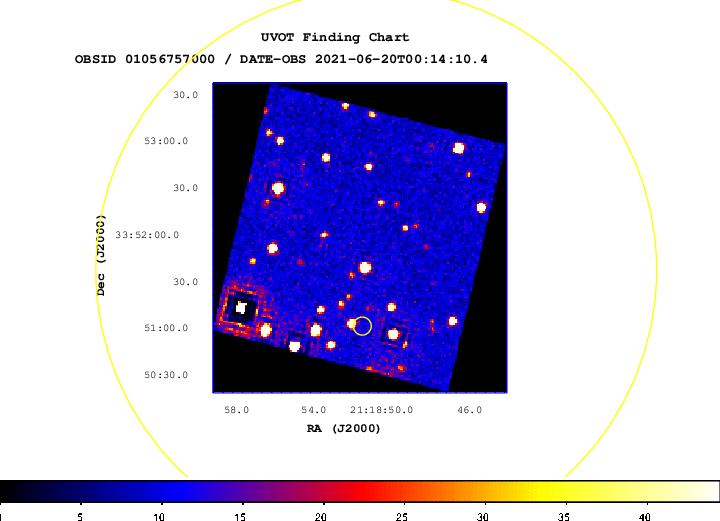
- GCN NOTICE
TITLE: GCN/SWIFT NOTICE
NOTICE_DATE: Sun 20 Jun 21 00:16:42 UT
NOTICE_TYPE: Swift-UVOT Source List
TRIGGER_NUM: 1056757, Seg_Num: 0
POINT_RA: 319.682d {+21h 18m 44s} (J2000)
POINT_DEC: +33.840d {+33d 50' 23"} (J2000)
POINT_ROLL: 47.457d
IMG_START_DATE: 19385 TJD; 171 DOY; 21/06/20
IMG_START_TIME: 823.17 SOD {00:13:43.17} UT, 857.8 [sec] since BAT Trigger Time
FILTER: 10, White
BKG_MEAN: 2.448
N_STARS: 190
X_OFFSET: 450 [pixels]
Y_OFFSET: 217 [pixels]
X_MAX: 1889 [pixels]
Y_MAX: 1656 [pixels]
DET_THRESH: 13
PHOTO_THRESH: 7
SL_URL: sw01056757000msufc0857.fits
SUN_POSTN: 88.82d {+05h 55m 18s} +23.43d {+23d 25' 53"}
SUN_DIST: 104.85 [deg] Sun_angle= 8.6 [hr] (West of Sun)
MOON_POSTN: 202.71d {+13h 30m 50s} -5.43d {-05d 25' 39"}
MOON_DIST: 115.49 [deg]
MOON_ILLUM: 70 [%]
GAL_COORDS: 80.31,-10.90 [deg] galactic lon,lat of the pointing direction
ECL_COORDS: 336.79, 46.44 [deg] ecliptic lon,lat of the pointing direction
COMMENTS: SWIFT-UVOT Source List.
- GCN Circular #30262
V. Lipunov, E. Gorbovskoy, V.Kornilov, D.Kuvshinov, N.Tyurina, P.Balanutsa,
A.Kuznetsov, D. Vlasenko, F. Balakin, I. Gorbunov
Lomonosov Moscow State University,
Sternberg Astronomical Institute, Moscow State University
R. Rebolo, M. Serra, N. Lodieu, G. Israelian, L. Suarez-Andres
The Instituto de Astrofisica de Canarias
K. Ivanov, O. Gres, N.M. Budnev, S. Yazev, O. Chuvalaev, V. Poleshchuk
Irkutsk State University
A. Tlatov, V.Senik, A.V. Parhomenko, D. Dormidontov
Kislovodsk Solar Station of the Pulkovo Observatory
V. Yurkov, A. Gabovich, Yu. Sergienko
Blagoveschensk Educational State University, Blagoveschensk
D. Buckley, S. Potter, A. Kniazev, M. Kotze
South African Astronomical Observatory
R. Podesta, Carlos Lopez and F. Podesta
Observatorio Astronomico Felix Aguilar (OAFA)
MASTER-IAC robotic telescope (Global MASTER-Net: http://observ.pereplet.ru, Lipunov et al., 2010, Advances in Astronomy, vol. 2010, 30L) located in Spain (IAC Teide Observatory) was pointed to the GRB210619.99 23 sec after notice time and 37 sec after trigger time at 2021-06-20 00:00:03 UT. On our first (10s exposure) set we found 1 optical transient within Swift error-box (ra=319.713 dec=33.86 r=0.05) brighter than 15.6.
T-Tmid Date Time Expt. Ra Dec Mag
---------|---------------------|-------|-----------------|-----------------|-------
42 2021-06-20 00:00:03 10 (21h 18m 52.38s , +33d 51m 01.4s) 10.7
The 5-sigma upper limit has been about 15.6mag
The message may be cited.
- GCN Circular #30263
M. Jelinek, J. Strobl, R. Hudec, C. Polasek (ASU CAS Ondrejov)
report:
We observed the position of the bright GRB 210420B (D'Avanzo et al., GCN
30261) with the D50 telescope of the Astronomical Institute Ondrejov, near
Prague, Czech Republic. We performed a series of unfiltered exposures
starting 23:59:53 UT, between 28 s and 2 h after the trigger.
The optical afterglow (Lipunov et al., GCNC30259 & 30262) is clearly
detected in single images. We can confirm a decaying nature of the object -
the afterglow faded to r'(AB)~17.7 mag during the course of our
observations, which were ended by twillight 2.0h after the trigger. The
alpha decay by the end of observations was ~0.6, indicating a possible
plateau phase.
- GCN Circular #30264
Y. Zhao, S. L. Xiong, Y. Huang, S. L. Xie, S. Xiao, C. Cai, J. C. Liu,
C. Y. Li, Y. Q. Zhang, W. C. Xue, C. Zheng, Z. W. Guo, X. Y. Zhao,
Z. H. An, C. Chen, G. Chen, W. Chen, M. Gao, K. Gong, D. Y. Guo, J. J. He,
B. Li, C. Li, J. H. Li, Q. X. Li, X. B. Li, X. Q. Li, Y. G. Li, X. H. Liang,
J. Y. Liao, J. C. Liu, X. J. Liu, Y. Q. Liu, F. J. Lu, Q. Luo, X. Ma,
G. Ou, W. X. Peng, R. Qiao, D. L. Shi, J. Y. Shi, L. M. Song,
X. Y. Song, G. X. Sun, X. L. Sun, Y. L. Tuo, C. W. Wang, J. Z. Wang,
P. Wang, X. Y. Wen, Y. B. Xu, Y. P. Xu, S. Yang, M. Yao, Q. B. Yi,
B. X. Zhang, C. Y. Zhang, D. L. Zhang, Fan Zhang, Fei Zhang, H. M. Zhang,
K. Zhang, P. Zhang, S. N. Zhang, Z. Zhang, S. Y. Zhao, S. J. Zheng,
X. Zhou (IHEP), report on behalf of GECAM team:
During the commissioning phase, GECAM-B was triggered in-flight by a long
burst at 2021-06-20T00:00:00.950 UTC (denoted as T0), which was also
observed by Swift/BAT (GCN # 30261) and CALET/GBM (trigNum 1308182178).
Its alert data was promptly downlinked to the ground through the short
message service of BeiDou Navigation Satellite System (BDS). The time
latency of the first BeiDou message relative to the trigger time is about
1 minute.
According to the BDS alert data, this burst mainly consists of multiple
pulses with a duration of more than 60 s. An automatic on-ground
localization was calculated using the light curves and spectrum. Although
the in-flight calibration of energy response and localization has not been
finalized yet, GECAM-B localized this burst to the following position (J2000):
Ra: 318.7 deg
Dec: 29.2 deg
Err: 7.4 deg (1-sigma, statistical only)
The current systematic error of location is estimated to be several degrees
which could be minimized by the ongoing calibration.
This GECAM location is consistent with that of Swift/BAT within the error.
The GECAM light curve could be found here:
http://twiki.ihep.ac.cn/pub/GECAM/GRBList/gecamb_lc_grd_all_combine_77846400.png
The GECAM preliminary location could be found here:
http://twiki.ihep.ac.cn/pub/GECAM/GRBList/gecamb_skymap_bdm_77846400_V01.png
Please note that all GECAM results here are preliminary. The final analysis
will be published in journal papers or GECAM online catalog.
Gravitational wave high-energy Electromagnetic Counterpart All-sky Monitor
(GECAM) mission consists of two small satellites (GECAM-A and GECAM-B) in
Low Earth Orbit (600 km, 29 deg), launched on Dec 10, 2020 (Beijing Time),
which was funded by the Chinese Academy of Sciences (CAS).
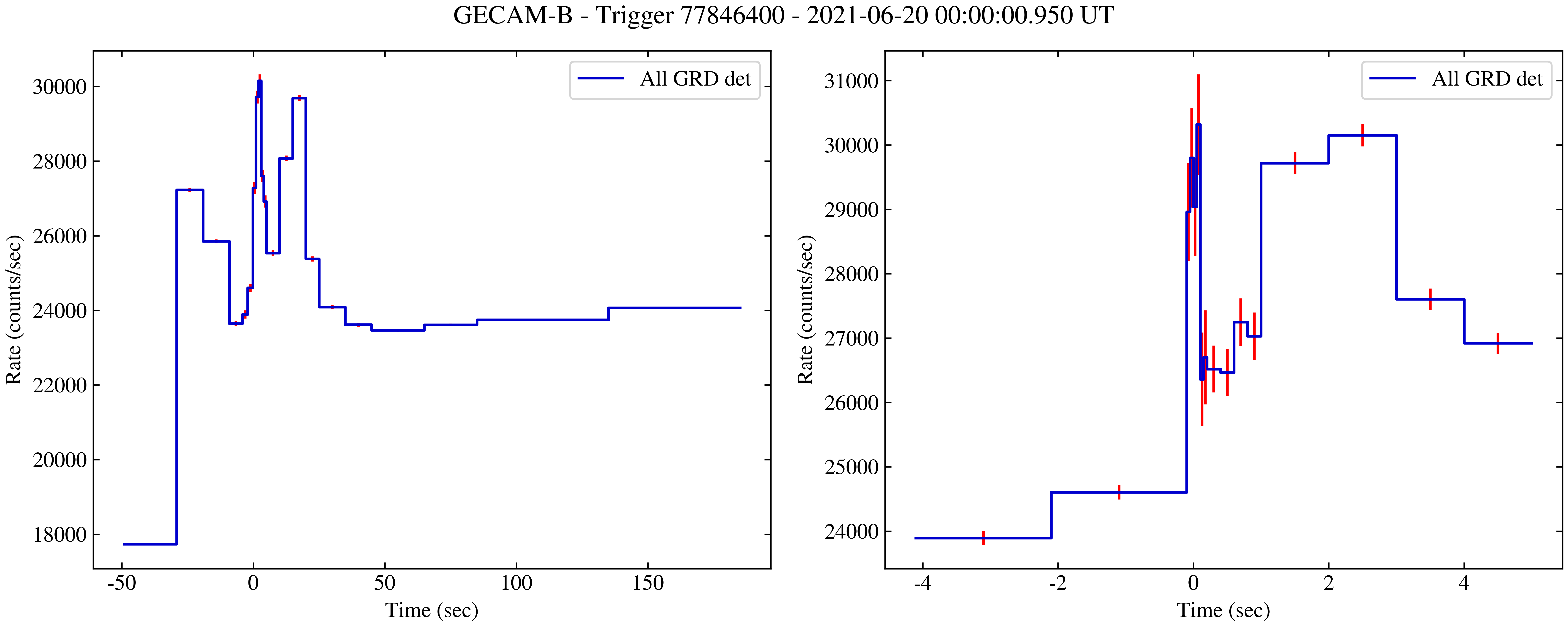
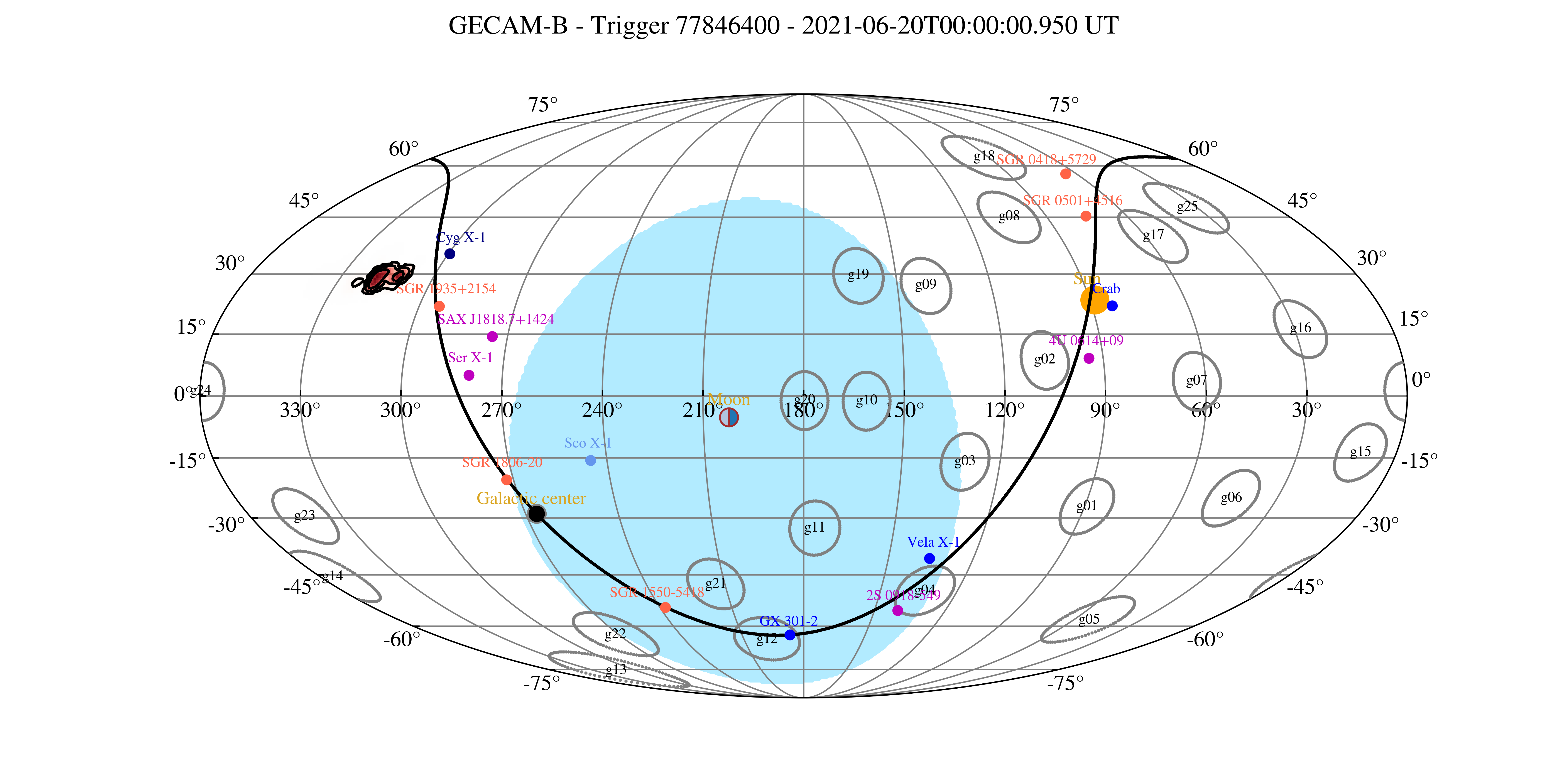
- GCN Circular #30265
A.K.H. Kong (NTHU, Taiwan) reports
We observed the field of GRB 210619B (D'Avanzo et al., GCN 30261) with the
T18 0.32m telescope of iTelescope.Net in Nerpio, Spain. The observation was
done with a V-band filter beginning at 2021-06-20 02:37:43 UT (about 2.6
hours after the trigger) for 180 sec. The optical afterglow (D'Avanzo et
al., GCN 30261) was detected with V=17.9+/-0.2 by calibrating with the
APASS DR10 catalogue.
- GCN Circular #30267
A.P. Beardmore, P.A. Evans, M.R. Goad and J.P. Osborne (U. Leicester)
report on behalf of the Swift-XRT team.
Using 1170 s of XRT Photon Counting mode data and 2 UVOT
images for GRB 210619B, we find an astrometrically corrected X-ray
position (using the XRT-UVOT alignment and matching UVOT field sources
to the USNO-B1 catalogue): RA, Dec = 319.71848, +33.85002 which is equivalent
to:
RA (J2000): 21h 18m 52.44s
Dec (J2000): +33d 51' 00.1"
with an uncertainty of 2.1 arcsec (radius, 90% confidence).
This position may be improved as more data are received. The latest
position can be viewed at http://www.swift.ac.uk/xrt_positions. Position
enhancement is described by Goad et al. (2007, A&A, 476, 1401) and Evans
et al. (2009, MNRAS, 397, 1177).
This circular was automatically generated, and is an official product of the
Swift-XRT team.
- GCN Circular #30268
K. Pellegrin, S. Anandagoda, and D. Hartmann report:
We observed the field of GRB 210619B detected by Swift BAT (D’Avanzo et al.,
GCN #30261), Global MASTER-Net (Lipunov et al., GCN #30262), GECAM (Zhao et
al., GCN #30264), iTelescope (Kong, GCN #30265), and Ondrejov D50 (M.
Jelinek et al., GCN #30263) using the SARA 0.9m optical telescope located
at Kitt Peak, AZ, USA, equipped with the Alta-E6-1105 camera.
Observation started at 05:19:14 UTC on 2021-06-20 and ended at 06:13:23 UTC
on 2021-06-20. We obtained a series of 60s exposure frames in the
Johnson-Cousins R filter. We detect the optical afterglow of GRB 210619B at
the enhanced Swift-XRT position (Beardmore, et al., GCN #30267).
The estimated magnitude of the GRB afterglow was found by stacking 20
images of 60s each in the Johnson-Cousins R band filter. The GRB was
visible in each of the stacked images.
T_start-T0 (hrs) T_end-T0 (hrs) Start Date (UTC) Filter Magnitude
(mag)
----------------------------------------------------------------------------------------------------------------
----------------------------------------------------------------------------------------------------------------
5.32 5.70 2021-06-20T05:19:14 R 18.51
5.73 6.22 2021-06-20T05:43:59 R 18.77
Photometry is done based on the PanSTARRS catalog.
The Southeastern Association for Research in Astronomy (SARA) consortium
operates three telescopes: the 0.9-m SARA-KP at Kitt Peak in Arizona, and
the 0.6-m SARA-CT at Cerro Tololo in Chile, and the 1.0-m SARA-RM (formerly
the JKT) telescope at Roque de los Muchachos Observatory in the Canary
Islands. For more information see: Keel et al. (2016):
https://iopscience.iop.org/article/10.1088/1538-3873/129/971/015002
- GCN Circular #30269
K.L. Page (U. Leicester), A.P. Beardmore (U. Leicester), E. Ambrosi
(INAF-IASFPA) , M. Capalbi (INAF-IASFPA), M. Perri (SSDC & INAF-OAR),
A. Tohuvavohu (U. Toronto), B. Sbarufatti (PSU), D.N. Burrows (PSU),
P.A. Evans (U. Leicester) and P. D'Avanzo report on behalf of the
Swift-XRT team:
We have analysed 6.7 ks of XRT data for GRB 210619B (D'Avanzo et al.
GCN Circ. 30261), from 208 s to 24.8 ks after the BAT trigger. The
data comprise 1.5 ks in Windowed Timing (WT) mode with the remainder in
Photon Counting (PC) mode. The enhanced XRT position for this burst was
given by Beardmore et al. (GCN Circ. 30267).
The light curve can be modelled with an initial power-law decay with an
index of alpha=0.938 (+/-0.014), followed by a break at T+5780 s to an
alpha of 1.23 (+/-0.07).
A spectrum formed from the WT mode data can be fitted with an absorbed
power-law with a photon spectral index of 1.886 (+/-0.019). The
best-fitting absorption column is 2.68 (+/-0.08) x 10^21 cm^-2, in
excess of the Galactic value of 2.0 x 10^21 cm^-2 (Willingale et al.
2013). The PC mode spectrum has a photon index of 1.88 (+/-0.08) and a
best-fitting absorption column of 2.6 (+/-0.3) x 10^21 cm^-2. The
counts to observed (unabsorbed) 0.3-10 keV flux conversion factor
deduced from this spectrum is 4.0 x 10^-11 (5.4 x 10^-11) erg cm^-2
count^-1.
A summary of the PC-mode spectrum is thus:
Total column: 2.6 (+/-0.3) x 10^21 cm^-2
Galactic foreground: 2.0 x 10^21 cm^-2
Excess significance: 2.8 sigma
Photon index: 1.88 (+/-0.08)
If the light curve continues to decay with a power-law decay index of
1.23, the count rate at T+24 hours will be 0.24 count s^-1,
corresponding to an observed (unabsorbed) 0.3-10 keV flux of 9.4 x
10^-12 (1.3 x 10^-11) erg cm^-2 s^-1.
The results of the XRT-team automatic analysis are available at
http://www.swift.ac.uk/xrt_products/01056757.
This circular is an official product of the Swift-XRT team.
- GCN Circular #30270
M. Axelsson (KTH & Stockholm Univ.), R. Pillera (Politecnico and INFN
Bari) and
F. Longo (University and INFN Trieste.) report on behalf of the
Fermi-LAT Collaboration:
Fermi-LAT has detected high-energy emission from GRB 210619B, which was
also detected
by Swift (GCN 30261), Global MASTER-net (GCN 30262), Ondrejov D50 (GCN
26263),
GECAM (GCN 26264), iTelescope T18 (GCN 30265) and SARA-KP (GCN 30268).
The best LAT on-ground location is found to be
(RA, Dec) = 319.7, 33.9 (degrees, J2000)
with an error radius of 0.13 deg (90% containment, statistical error
only). This position
is consistent with the XRT localization (GCN 30267). The location of the
GRB was outside
the LAT FoV at the time of the trigger (T0 = 23:59:25 UT on 2021-06-19)
and came into
view at T0+200 s.
The data from the Fermi-LAT show a significant increase in the event
rate that is spatially
correlated with the Swift emission with high significance. The highest
energy photon is a
8.3 GeV event detected ~410 s after the trigger.
The photon flux above 100 MeV in the time interval 200-1000 s after the
Swift trigger is
(1.6 +/- 1.2) e-06 ph/cm2/s.
The estimated photon index above 100 MeV is -1.5 +/- 0.3.
The Fermi-LAT point of contact for this burst is
Roberta Pillera (roberta.pillera@ba.infn.it).
The Fermi-LAT is a pair conversion telescope designed
to cover the energy band from 20 MeV to greater than 300 GeV.
It is the product of an international collaboration
between NASA and DOE in the U.S. and many scientific institutions
across France, Italy, Japan and Sweden.
- GCN Circular #30271
D. A. Perley (LJMU) reports:
We acquired multicolor imaging of the optical afterglow of GRB 210619B
(D'Avanzo et al., GCN 30261) using the IO:O camera of the 2m robotic
Liverpool Telescope. The afterglow was observed twice in the ugriz
filters on 2021-06-20 UT, with the first epoch taking place between
02:35:06 and 02:42:40 and the second between 03:49:15 and 03:56:49.
Photometry with reference to Pan-STARRS 1 secondary standard stars in
the field gives the following magnitudes:
t-tburst(d) filter mag unc
0.10772 g 18.58 0.03
0.10879 r 17.82 0.03
0.10984 i 17.44 0.04
0.11227 z 17.17 0.04
0.15920 g 18.93 0.03
0.16028 r 18.11 0.03
0.16133 i 17.74 0.04
0.16376 z 17.47 0.04
These values have not been corrected for Galactic extintion.
The colors (after applying a Galactic extinction correction) suggest a
moderately dust-reddened afterglow.
- GCN Circular #30272
A. de Ugarte Postigo (HETH/IAA-CSIC, DARK/NBI), D. A. Kann, C. Thoene, M. Blazek, J.F. Agui Fernandez, (all HETH/IAA-CSIC), L. Izzo (DARK/NBI), N.R. Tanvir (U. Leicester), J.P.U. Fynbo (DAWN/NBI), A. M. Garcia Rodriguez, and G. Gomez (GTC) report:
We observed the afterglow of GRB 210619B (D’Avanzo et al. GCN 30261; Lipunov et al. GCN 30262; Jelinek et al. GCN 30263; Zhao et al. GCN 30264; Kong GCN 30265; Beardmore et al. GCN 30267; Pellegrin et al. GCN 30268; Axelsson et al., GCN 30270; Perley GCN 30271) with OSIRIS on the 10.4 m GTC telescope at Roque de los Muchachos Observatory, in the Island of La Palma. The observation started at 2:27 UT (2.45 hr after the burst) and consisted of 3x600 s with grism R1000B, covering the spectral range between 3700 and 7800 AA.
In a preliminary reduction with old calibrations we detect a strong continuum with a plethora of absorption features superposed to it. We identify features that include SiII, SiIV, OI, CI, CII, CIV, FeII, AlII, AlIII, NiII, CrII ZnII, as well as fine structure lines of SiII, FeII, NiII at a common redshift of 1.937, which we identify as the redshift of the GRB. We also detect an intervening system with MgII and MgI at z=1.095.
Additionally, the flux calibrated spectrum shows a strong broad absorption feature at ~4500AA, resembling a dust bump. This could be consistent with a 2175 AA dust feature due to the intervening absorber.
We note that at a redshift of 1.937, the initial prompt emission spike is extremely luminous, and we expect the afterglow to be among the most luminous prompt flashes ever detected. Using the fluence reported on the automatic Swift/BAT analysis page in the 15-350 keV band, we derive an E_iso ~ 1.7e54 erg, without any k-correction. This implies GRB 210619B will likely be among the most energetic GRBs ever detected once a k-correction to the bolometric band is applied.
Further analysis is ongoing. We encourage further observations.
- GCN Circular #30273
WeiKang Zheng and Alexei V. Filippenko (UC Berkeley) report on
behalf of the KAIT GRB team:
The 0.76-m Katzman Automatic Imaging Telescope (KAIT), located at
Lick Observatory, responded to the Swift GRB 210619B (D'Avanzo et al.,
GCN 30261) starting at ~8.05 hours after the Swift trigger.
A total of 60x60s images were obtained in the clear (roughly R)
filter. The optical afterglow (D'Avanzo et al., GCN 30261; Lipunov et al.,
GCN 30262; Jelinek et al., GCN 30263; Kong, GCN 30265; Pellegrin et al.,
GCN 30268; Perley, GCN 30271) was clearly detected in each single image.
We measured its brightness of 18.5 +/- 0.1 mag at 8.05 hours after burst,
and decayed to be 18.8 +/- 0.1 mag at 11.07 hours after burst, calibrated
to the Pan-STARRS1 catalog.
- GCN Circular #30274
M. Blazek, D. A. Kann (both HETH/IAA-CSIC), A. de Ugarte-Postigo (HETH/IAA-CSIC,
DARK/NBI), C. Thoene and J.F. Agui Fernandez (both HETH/IAA-CSIC) report:
We observed the afterglow of GRB 210619B (Swift detection: D'Avanzo et al., GCN
30261; GECAM detection: Zhao et al., GCN 30264; Fermi-LAT detection: Axelsson et
al., GCN 30270; Afterglow detections: Lipunov et al., GCN 30259; D'Avanzo et
al., GCN 30261; Lipunov et al., GCN 30262; Jelinek et al., GCN 30263; Kong, GCN
30265; Pellegrin et al., GCN 30268; Perley, GCN 30271; Zheng & Filippenko, GCN
30273; Redshift: de Ugarte Postigo, GCN 30272) with the 2-m Liverpool Telescope
located in La Palma, Spain using IO:O camera. The observation started at
02:57:49 UT on June 20, 2021 (t-t0 = 2.97 hours). We obtained 60x45 seconds
exposures in r'. The afterglow is clearly detected in each image. Comparing
to 33 check stars from the PanSTARRS catalogue we derived the decay starting with
r' = 17.91 +- 0.01 mag
and ending at 03:45:43 UT (t-t0 = 3.77) hours with
r' = 18.10 +- 0.02 mag
Magnitudes are given in AB photometric system. These values have not been
corrected for Galactic extintion.
- GCN Circular #30275
D. A. Kann (HETH/IAA-CSIC), A. de Ugarte Postigo (HETH/IAA-CSIC,
DARK/NBI), M. Blazek, C. Thoene, J.F. Agui Fernandez, Ginger (all
HETH/IAA-CSIC), and J. I. Vico Linares (CAHA) report:
We observed the afterglow of GRB 210619B (Swift detection: D'Avanzo et
al., GCN 30261; GECAM detection: Zhao et al., GCN 30264; Fermi-LAT
detection: Axelsson et al., GCN 30270; Afterglow detections: Lipunov et
al., GCN 30259; D'Avanzo et al., GCN 30261; Lipunov et al., GCN 30262;
Jelinek et al., GCN 30263; Kong, GCN 30265; Pellegrin et al., GCN 30268;
Perley, GCN 30271; Zheng & Filippenko, GCN 30273; Blazek et al., GCN
30274; Redshift: de Ugarte Postigo, GCN 30272) with CAFOS mounted at the
2.2m Calar Alto telescope (Almeria, Spain). After a weather-induced
delay, we obtained 80 x 60 s images in Ic. The afterglow is clearly
detected in each image.
The sequence starts at 01:23 UT and ends at 03:43 UT on 2021-06-20
(0.05836 to 0.15479 d after burst trigger). Comparing to a single star
with a magnitude derived from PanSTARRS and transformed following Lupton
(2005), we find the afterglow decays from Ic (AB) = 16.75 +/- 0.05 mag
to Ic (AB) = 17.45 +/- 0.05 mag.
Further observations are planned.
- GCN Circular #30276
D. Svinkin, S. Golenetskii, D. Frederiks, M. Ulanov,
A. Tsvetkova, A. Lysenko, A. Ridnaia, and T. Cline
on behalf of the Konus-Wind team, report:
The very bright, long-duration GRB 210619B
(Swift-BAT detection: D'Avanzo et al., GCN Circ. 30261;
GECAM detection: Zhao et al., GCN Circ. 30264;
Fermi-LAT detection: Axelsson et al., GCN Circ. 30270)
triggered Konus-Wind at T0=86368.157 s UT (23:59:28.157).
The burst light curve shows a bright hard initial episode,
which starts at ~T0 and has a duration of ~10 s,
followed by weaker pulses. The total burst duration is ~80 s.
The emission is seen up to ~15 MeV.
The Konus-Wind light curve of this GRB is available at
http://www.ioffe.ru/LEA/GRBs/GRB210619_T86368/
As observed by Konus-Wind, the burst
had a fluence of 4.60(-0.13,+0.13)x10^-4 erg/cm2,
and a 64-ms peak flux, measured from T0+0.640 s,
of 1.54(-0.12,+0.12)x10^-4 erg/cm2/s
(both in the 20 keV - 10 MeV energy range).
The time-averaged spectrum of the burst
(measured from T0 to T0+66.816 s)
is best fit in the 20 keV - 15 MeV range
by the GRB (Band) model with the following parameters:
the low-energy photon index alpha = -1.02(-0.03,+0.04),
the high energy photon index beta = -2.10(-0.04,+0.03),
the peak energy Ep = 261(-13,+14) keV
(chi2 = 118/96 dof).
The spectrum near the maximum count rate
(measured from T0+0.512 to T0+0.768 s)
is best fit in the 20 keV - 15 MeV range
by the GRB (Band) model with the following parameters:
the low-energy photon index alpha = -0.41(-0.11,+0.12),
the high energy photon index beta = -2.06(-0.12,+0.09),
the peak energy Ep = 572(-81,+98) keV
(chi2 = 76/60 dof).
Assuming the redshift z=1.937
(de Ugarte Postigo et al., GCN Circ. 30272)
and a standard cosmology model with H_0 = 67.3 km/s/Mpc,
Omega_M = 0.315, and Omega_Lambda = 0.685 (Planck Collaboration, 2014),
we estimate the following rest-frame parameters:
the isotropic energy release E_iso is 4.41(-0.12,+0.12)x10^54 erg,
the peak luminosity L_iso is 4.34(-0.34,+0.34)x10^54 erg/s,
the rest-frame peak energy of the time-integrated spectrum,
Ep,i,z, is 767(-38,+41) keV, and the rest-frame peak energy of
the 'peak' spectrum, Ep,p,z, is 1680(-238,+288) keV.
With these energetics, the burst lies within the 90% prediction bands
for both 'Amati' and 'Yonetoku' relations built for the sample
of 138 long KW GRBs with known redshifts
(Tsvetkova et al., ApJ 850 161, 2017),
see http://www.ioffe.ru/LEA/GRBs/GRB210619_T86368/GRB210619B_rest_frame.pdf.
Among the KW GRB sample, GRB 210619B is within top 4% in the terms
of E_iso and have L_iso comparable to the most luminous GRB 110918A
(Frederiks et al., ApJ 779, 151, 2013).
All the quoted errors are at the 90% confidence level.
All the quoted values are preliminary.
- GCN Circular #30277
L. P. Xin (NAOC), X. Li (THU), Y. L. Qiu(NAOC), J. Y. Wei(NAOC),
J. Wang(GXU), L. H. Li (NAOC), C. Wu(NAOC), E. W. Liang(GXU),
X. H. Han (NAOC), A. Y. Zhou (NAOC) and J. S. Deng(NAOC) report:
We began to observe GRB 210619B (Swift detection: D'Avanzo et al., GCN
30261; GECAM detection: Zhao et al., GCN 30264; Fermi-LAT detection:
Axelsson et al., GCN 30270; Konus-Wind detection: Svinkin et al., GCN 30276;
Afterglow detections: Lipunov et al., GCN 30259; D'Avanzo et
al., GCN 30261; Lipunov et al., GCN 30262; Jelinek et al., GCN 30263;
Kong, GCN 30265; Pellegrin et al., GCN 30268; Perley, GCN 30271;
Zheng & Filippenko, GCN 30273; Redshift: de Ugarte Postigo, GCN 30272,
Blazek et al., GCN 30274; Kann et al., 30275) with Xinglong TNT telescope,
China, at 15:23:44 (UT), 20th. June. 2021, about 14.43 hours after the burst,
A series of R and B band images were obtained.
The afterglow is clear detected in our single image with a magnitude of 19.0 mag
in R band comparing to several nearby USNO B1.0 stars.
Observations are still continuing.
We acknowledge the excellent support from Xinglong staff YuGuang Sun.
The message may be cited.
- GCN Circular #30278
N. P. M. Kuin (UCL-MSSL) and P. D'Avanzo (INAF-OAB) report
on behalf of the Swift/UVOT team:
The Swift/UVOT began settled observations of the field of GRB 210619B
136 s after the BAT trigger (D'Avanzo et al., GCN Circ. 30261).
A source consistent with the XRT position (Beardmore et al., GCN Circ.
30267)
was detected in the initial UVOT exposures consistent with the reported
afterglow by Lipunov et al. (GCN Circ. 30259), Jelinek et al. (GCN Circ.
30263),
Kong (GCN Circ. 30265), Kellegrin et al. (GCN Circ. 30268), and Zheng &
Filippenko (GCN Circ. 30273). A redshift measurement of z=1.937 was
reported
by de Ugarte Postigo et al. (GCN Circ. 20272) which puts the Lyman break
right at the center of the UVOT uvm2 filter.
The preliminary UVOT position is:
RA (J2000) = 21:18:52.38 = 319.71825 (deg.)
Dec (J2000) = +33:51:01.6 = 33.85044 (deg.)
with an estimated uncertainty of 0.42 arc sec. (radius, 90% confidence).
Preliminary detections and 3-sigma upper limits using the UVOT photometric
system
(Breeveld et al. 2011, AIP Conf. Proc. 1358, 373) for the early exposures
are:
Filter T_start(s) T_stop(s) Exp(s) Mag
white 136 285 147 14.67 +/- 0.02
white 794 814 19 16.66 +/- 0.06
v 679 699 19 15.59 +/- 0.10
b 604 624 20 16.39 +/- 0.08
u 348 598 246 15.60 +/- 0.03
w1 729 1107 39 17.22 +/- 0.19
m2 704 1776 117 >19.3
w2 655 1726 136 19.20 +/- 0.31
The magnitudes in the table are not corrected for the Galactic extinction
due to the reddening of E(B-V) = 0.173 in the direction of the burst
(Schlegel et al. 1998).
- GCN Circular #30279
S. Poolakkil (UAH) and C. Meegan (UAH)
report on behalf of the Fermi GBM Team:
"At 23:59:25.60 UT on 19 June 2021, the Fermi Gamma-Ray Burst Monitor (GBM)
triggered and located GRB 210619B (trigger 645839970 / 210619999)
which was also detected by the Swift/BAT (D'Avanzo et al. 2021, GCN 30261),
Fermi-LAT (Axelsson et al. 2021, GCN 30270) and Konus-Wind (Svinkin et
al. 2021, GCN 30276).
The GBM on-ground location is consistent with the Swift position.
The angle from the Fermi LAT boresight at the GBM trigger time is 109 degrees.
The GBM light curve consists of a single peak followed by some
extended emission with a duration (T90) of about 55 s (50-300 keV).
The time-averaged spectrum from T0 s to T0+61.4 s
is best fit by a Band function, with Epeak = 210 +/- 3 keV,
alpha = -0.86 +/- 0.01 and beta = -1.99 +/- 0.01.
The event fluence (10-1000 keV) in this time interval is
(307.93 +/- 0.9830)E-06 erg/cm^2. The 1-sec peak photon flux measured
starting from T0+0.51 s in the 10-1000 keV band
is 238.6 +/- 1.3 ph/s/cm^2.
The spectral analysis results presented above are preliminary;
final results will be published in the GBM GRB
Catalog:https://heasarc.gsfc.nasa.gov/W3Browse/fermi/fermigbrst.html
For Fermi GBM data and info, please visit the official Fermi GBM
Support Page:https://fermi.gsfc.nasa.gov/ssc/data/access/gbm/"
- GCN Circular #30280
M. Shrestha (Liverpool JMU), A. Gomboc (Univ. Nova Gorica), C. Guidorzi (U=
niv. Ferrara) , S. Kobayashi (LJMU), A. Melandri (INAF), C. Mundell (Univ.=
Bath), R. Smith (LJMU) , I.A. Steele (LJMU), report on behalf of a wider c=
ollaboration:
We observed the field of Swift GRB 210619B (D'Avanzo et al. GCN 30261; Jeli=
nek et al. GCN 30263; Lipunov et al. GCN 30259; Zhao et al. GCN 30261; Kong=
et al. GCN 30265; Axelsson et al. GCN 30270; de Ugarte Postigo et al. GCN =
30272; Zheng et al. GCN 30273; Blazek et al. GCN 30274; Kann et al. GCN 302=
75; Svinkin et al. GCN 30276; Xin et al. GCN 30277; Perley et al. GCN 30271=
) with the 2.0m Liverpool Telescope (LT), La Palma on 2021 June 20 startin=
g at 00:21:14.141 UT for a period of 2 hours using the MOPTOP optical imagi=
ng polarimeter in the r=92 band. Data was calibrated with respect to nearb=
y APASS secondary standard stars.
We confirm the optical counterpart reported by Swift UVOT (GCN 30261).
At T=1318 seconds after the BAT trigger time, we measure r=92 =3D 16.1 ma=
g. Detailed analysis is ongoing.
________________________________
Important Notice: Liverpool John Moores University was established as a Hig=
her Education Corporation under section 121 of the Education Reform Act 198=
8. Further information about Liverpool John Moores University can be found =
at https://www.ljmu.ac.uk/about-us The information in this email and any at=
tachments is for the sole use of the intended recipient(s). If you are not =
an intended recipient, or a person responsible for delivering it to an inte=
nded recipient, you should delete it from your system immediately without d=
isclosing its contents elsewhere and advise the sender by returning the ema=
il or by telephoning a number contained in the body of the email. No respon=
sibility is accepted for loss or damage arising from viruses or changes mad=
e to this message after it was sent and the recipient must ensure that the =
email (and attachments) are virus free. The views contained in this email a=
re those of the author and not necessarily those of Liverpool John Moores U=
niversity. We will use the personal data information provided by you to res=
pond to your email. For information about how we process personal data and =
monitor communications please see our Privacy Notice. https://www.ljmu.ac.u=
k/legal/privacy-and-cookies
- GCN Circular #30281
M. Jelinek, J. Strobl, R. Hudec, C. Polasek (ASU CAS Ondrejov)
report:
We observed the optical afterglow of GRB 210619B (D'Avanzo et al. GCN
30261; Jelinek et al. GCN 30263; Lipunov et al. GCN 30259; Zhao et al. GCN
30261; Kong et al. GCN 30265; Axelsson et al. GCN 30270; de Ugarte Postigo
et al. GCN 30272; Zheng et al. GCN 30273; Blazek et al. GCN 30274; Kann et
al. GCN 30275; Svinkin et al. GCN 30276; Xin et al. GCN 30277; Perley et
al. GCN 30271, Shrestha et al. GCN 30280) with the D50 in Ondrejov through
difficult conditions with some passing clouds.
On a combined (86x60s, Sloan r') image with the mean exposure time 0.98
days post burst we measure r'(AB) = 20.2 +- 0.2. This is significantly
below any extrapolation of photometric points published before, and
suggests a break and a steepening of the decay.
- GCN Circular #30282
A. Y. Lien (GSFC/UMBC), S. D. Barthelmy (GSFC),
P. D'Avanzo (INAF-OAB), H. A. Krimm (NSF),
S. Laha (GSFC/UMBC), C. B. Markwardt (GSFC),
D. M. Palmer (LANL), T. Sakamoto (AGU),
M. Stamatikos (OSU), T. N. Ukwatta (LANL)
(i.e. the Swift-BAT team):
Using the data set from T-240 to T+962 sec from the recent telemetry
downlink, we report further analysis of BAT GRB 210619B (trigger #1056757)
(D'Avanzo et al., GCN Circ. 30261). The BAT ground-calculated position is
RA, Dec = 319.718, 33.850 deg which is
RA(J2000) = 21h 18m 52.3s
Dec(J2000) = +33d 50' 58.6"
with an uncertainty of 1.0 arcmin, (radius, sys+stat, 90% containment).
The partial coding was 36%.
The mask-weighted light curve shows a bright pulse that starts at ~T0
and peaks at ~T+1 s, and is followed by several overlapping pulses that
last till ~T+105 s. T90 (15-350 keV) is 60.90 +- 0.28 sec (estimated
error including systematics).
The time-averaged spectrum from T-0.25 to T+105.38 sec is best fit
by a simple power-law model. The power law index of the time-averaged
spectrum is 1.41 +- 0.02. The fluence in the 15-150 keV band is
9.5 +- 0.1 x 10^-5 erg/cm2. The 1-sec peak photon flux measured from
T+0.95 sec in the 15-150 keV band is 115.0 +- 2.2 ph/cm2/sec.
All the quoted errors are at the 90% confidence level.
The results of the batgrbproduct analysis are available at
http://gcn.gsfc.nasa.gov/notices_s/1056757/BA/
- GCN Circular #30283
V. Levin, S. Molkov, I. Mereminskiy, А. Lutovinov, A. Semena
and E. Filippova (IKI RAN)
report on behalf of SRG/ART-XC team:
At 23:59:21 UT on 19/06/2021 the Mikhail Pavlinsky ART-XC telescope on
board the Spektr-RG observatory
detected a short peak in the 40-120 keV count rate. This peak is
associated with the luminous GRB210619B
registered simultaneously by other space-bourne missions (Swift/BAT
(D'Avanzo et al. 2021, GCN 30261),
GECAM (Zhao et al. 2021, GCN 30264), Fermi-LAT (Axelsson et al. 2021,
GCN 30270), Konus-Wind
(Svinkin et al. 2021, GCN 30276), Fermi/GBM (Poolakkil and Meegan 2021,
GCN 30279)).
The burst light curve is similar to what observed by other telescopes,
with a prominent initial peak
(that lasted for 6 s and having a typical fast rise exponential decay
form) and several
consecutive peaks, roughly coincident with ones detected by Konus-Wind.
The angle between telescope axis and the burst was 45 degrees, which
means that the burst emission
had penetrated through the side shield of ART-XC detectors. This
significantly complicates the spectral analysis,
which will be presented elsewhere.
The Mikhail Pavlisky ART-XC is an X-ray telescope working in the hard
X-ray band (above 4 keV) in the
Langrangian point L2. It could observe brightest GRBs through its
side/back shielding, providing an
additional leverage for the IPN-like triangulation of such events.
- GCN Circular #30284
Y. Kawakubo (LSU),
A. Yoshida, T. Sakamoto, V. Pal'shin, S. Sugita (AGU),
K. Yamaoka (Nagoya U), S. Nakahira (RIKEN), Y. Asaoka (ICRR),
S. Torii, Y. Akaike, K. Kobayashi (Waseda U),
Y. Shimizu, T. Tamura (Kanagawa U), N. Cannady (GSFC/UMBC),
M. L. Cherry (LSU), S. Ricciarini (U of Florence),
P. S. Marrocchesi (U of Siena),
and the CALET collaboration:
The long bright GRB 210619B (Swift detection: D'Avanzo et al.,
GCN Circ. 30261, Lien et al., GCN Circ. 30282; GECAM detection: Zhao et al.,
GCN Circ. 30264; Fermi-LAT detection: Axelsson et al., GCN Circ. 30270;
Konus-Wind detection: Svinkin et al., GCN Circ. 30276;
Fermi GBM detection: Poolakkil and Meegan, GCN Circ. 30279;
SRG/ART-XC detection: Levin et al., GCN Circ. 30283;
https://gcn.gsfc.nasa.gov/other/210619B.gcn3) triggered the CALET Gamma-ray
Burst Monitor (CGBM) at 23:59:21.940 UTC on 19 June 2021
(http://cgbm.calet.jp/cgbm_trigger/flight/1308182178/index.html).
The burst signal was seen by all CGBM detectors.
The burst light curve shows the bright initial pulse which starts
at T+3.5 sec and peaks at T+4.3 sec, followed by several weaker pulses
which end at T+85.4 sec. The T90 and T50 durations measured by the SGM data
are 49.9 +- 1.8 sec and 14.4 +- 0.6 sec (40-1000 keV), respectively.
The ground processed light curve is available at
http://cgbm.calet.jp/cgbm_trigger/ground/1308182178/
The CALET data used in this analysis are provided by
the Waseda CALET Operation Center located at the Waseda University.
- GCN Circular #30286
H. Kumar(IITB), U. Stanzin (IAO), V. Bhalerao(IITB), G. C. Anupama(IIA), S.
Barway(IIA) report on behalf of the GIT team:
We observed GRB 210619B detected by Swift-BAT (D'Avanzo et al. GCN #30261)
also see(Lipunov et al. GCN #30259; Zhao et al. GCN #30261; Jelinek et al.
GCN #30263; Kong et al. GCN #30265; Axelsson et al. GCN #30270; Perley et
al. GCN #30271; de Ugarte Postigo et al. GCN #30272; Zheng et al. GCN
#30273; Blazek et al. GCN #30274; Kann et al. GCN #30275; Svinkin et al.
GCN #30276; Xin et al. GCN #30277; Shrestha et al. GCN #30280; Jelinek et
al. GCN #30281), with 0.7m GROWTH-India Telescope (GIT). We obtained multiple
300-sec exposures in the g', r' and i' filters starting at
2021-06-20T18:04:27 UT. We clearly detected the afterglow in our stacked images
at R.A.(J2000)= 21:18:52.39, DEC.(J2000)= +33:51:01.10. The photometric
results follow as:
-------------------------------------------------------------------
JD (mid) | T_mid - T0(hrs) | Filter | Magnitude (AB) |
-------------------------------------------------------------------
2459386.26006 | 18.25 | g' | 21.133 +/- 0.07 |
2459386.27823 | 18.69 | r' | 20.184 +/- 0.05 |
2459386.29675 | 19.14 | i' | 20.091 +/- 0.06 |
2459386.33501 | 20.05 | g' | 21.142 +/- 0.07 |
-------------------------------------------------------------------
Our r' magnitude is significantly fainter as compared to the extrapolation
of power-law from previous observations. We thus confirm jet-break in GRB
210619B, first suggested by Jelinek et al. GCN #30281. The magnitudes are
calibrated against PanSTARRS (Flewelling et al., 2018) and not corrected
for Galactic extinction.
The GROWTH India Telescope (GIT) is a 70-cm telescope with a 0.7-degree
field of view, set up by the Indian Institute of Astrophysics and the
Indian Institute of Technology Bombay with support from the Indo-US Science
and Technology Forum (IUSSTF) and the Science and Engineering Research
Board (SERB) of the Department of Science and Technology (DST), Government
of India (https://sites.google.com/view/growthindia/). It is located at the
Indian Astronomical Observatory (Hanle), operated by the Indian Institute
of Astrophysics (IIA).
- GCN Circular #30288
P. D'Avanzo, A. Melandri, S. Covino, D. Fugazza, (INAF-OAB) on behalf of the REM team, report:
We observed the field of GRB 210619B (D'Avanzo et al., GCN Circ. 30261) with the REM 60cm robotic telescope
located at the ESO premise of La Silla (Chile). The observations were carried in the g, r, i, z, J, H and K bands, starting
on 2021 June 20 at 06:07:59 UT (i.e. 6.14 hours after the burst) and lasting for about one hour.
The optical/NIR afterglow (D'Avanzo et al., GCN Circ. 30261) is detected in all bands. From preliminary photometry we
derive the following magnitudes:
r = 18.52 +/- 0.12
(AB; calibrated against the Pan-STARRS catalogue)
J = 17.10 +/- 0.24
H = 16.61 +/- 0.25
K = 15.13 +/- 0.23
(Vega; calibrated against the 2MASS catalogue)
at a mid time of t-t0 = 6.3 hours.
- GCN Circular #30289
P. D'Avanzo (INAF-OAB), V. D'Elia (ASI-SSDC), A. Melandri, G. Tagliaferri (INAF-OAB), A. Rossi (INAF-OAS),
L. Di Fabrizio, D. Carosati (INAF-TNG) on behalf of the CIBO collaboration report:
We observed the NIR afterglow of GRB 210619B (D'Avanzo et al., GCN Circ. 30261) with the Italian 3.6m TNG
telescope equipped with the near-infrared camera NICS. A series of images were obtained with the J and K filters
on 2021-06-21 from 01:27:06 UT to 02:49:36 UT (i.e. at a mid time of about 1.09 days after the burst).
With preliminary photometry we derive the following magnitudes:
J = 17.90 +/- 0.05
K = 16.43 +/- 0.11
(Vega; calibrated against the 2MASS catalogue).
- GCN Circular #30290
V. Cunningham (U of Maryland), J. D. Neill (Caltech), S. B. Cenko
(NASA GSFC), and R. Walters (Caltech) report on behalf of the SEDM
team:
We observed the optical counterpart to GRB 210619B (D'Avanzo et al.,
GCN 30261) with the Spectral Energy Distribution Machine (SEDM) on
the 60 inch telescope at Palomar Observatory. The SEDM is a low
resolution (R ~ 100) integral field unit spectrometer with a multi-band
(ugri) rainbow camera imager (see Blagorodnova et al. 2018, PASP,
130, 035003, and Rigault et al. 2019, A&A, 627, A115). The SEDM
began observing the optical counterpart at 00:01:33 UTC (1.5 hours
after the burst trigger time). We performed a 2880 s exposure over the
wavelength range 3800-9200 A.
The continuum emission is well-fit by a power law spectrum with index
alpha = 2.8 (f_nu ~ nu^-alpha). The noise level of the spectrum,
especially at wavelengths bluer than 5000 A, make it difficult to confirm
the redshift reported by OSIRIS/GTC (GCN 30272).
- GCN Circular #30291
A. S. Moskvitin and O. A. Maslennikova (SAO RAS),
report on behalf of the GRB follow-up team.
We observed the field of Swift GRB 210619B (D'Avanzo et al.,
GCNs #30261, #30288, #30289; Jelinek et al., GCNs #30263, #30281;
Lipunov et al., GCN #30259; Zhao et al., GCN #30261; Kong et al.,
GCN #30265; Axelsson et al., #GCN 30270; de Ugarte Postigo et al.,
GCN #30272; Zheng et al., GCN #30273; Blazek et al., GCN #30274;
Kann et al., GCN #30275; Svinkin et al., GCN #30276; Xin et al.,
GCN $30277; Perley et al., GCN #30271, Shrestha et al., GCN #30280,
Kumar et al. GCN #30286; Cunningham et al., GCN #30290)
with the SAO RAS 1-m telescope Zeiss-1000 + CCD-photometer.
We obtained 6 x 300 sec. frames in Rc band on June 20/21
(23:31:43--00:03:05 UT), T_mid-T0 = 0.99166d.
The OT is clearly detected in the stacked frame with the brightness
R = 19.8 +/- 0.1 (based on nearby USNO-B1 stars).
- GCN Circular #30292
I observed the field of GRB 210619B (D'Avanzo et al., GCN Circ. 30261)
using remote telescope T18 (0.32-m f/8.0 reflector + CCD) of
iTelescope.Net in observatory AstroCamp at Nerpio (Spain). Five images
(with exposures 300 seconds, BINx1) were obtained with Astrodon
luminance filter on 2021-06-20 from 23:06:46 to 23:36:44 UTC (until
the roof was closed due to poor weather).
I detected faint (SNR ~ 3) optical afterglow with UVOT position in
stacked image (mid time = 23:21:43 UTC, that is 0.974 days after the
trigger) and measured its magnitude from comparison to r' magnitudes
of nearby stars from Pan-STARRS DR1 catalogue (Chambers et al., 2016):
20.5 +/- 0.4. Magnitude was not corrected for Galactic extinction.
Stacked image available here:
https://www.flickr.com/photos/filipp-romanov/51261591951
- GCN Circular #30293
Y.-D. Hu, A. Sota, T.-R. Sun, A. J. Castro-Tirado, M. D. Caballero-Garcia, =
M. A. Castro Tirado and E. Fernandez-Garcia (IAA-CSIC), on behalf of a larg=
er collaboration, report:
Following the detection of GRB 210619B by Swift (D'Avanzo et al. GCN 30261)=
, GECAM (Zhao et al. GCN 30264), CALET (Kawakubo et al. GCNC 30284), SRG/AR=
T-XC (Levin et al. GCNC 30283), Fermi-LAT (Axelsson et al. GCNC 30270), Kon=
us-Wind (Svinkin et al. GCN 30276) and Fermi/GBM (Poolakkil et al. GCNC 302=
79), images in BVRI bands were obtained at the 1.5m OSN telescope in Granad=
a (Spain) starting on Jun 20, 22:33 UT. We detect the optical afterglow (Li=
punov et al. GCNC 30259; Lipunov et al. GCNC 30262; Jelinek et al. GCNC 302=
63; Kong et al. GCNC 30265; Pellegrin et al. GCNC 30268; D. Perley GCNC 302=
71; de Ugarte Postigo et al. GCNC 30272; Zheng et al. GCNC 30273; Blazek et=
al. GCNC 30274; Kann et al. GCNC 30275; Xin et al. GCNC 30277; Kuin et al.=
GCNC 30278, Shrestha et al. GCNC 30280; Jelinek et al. GCNC 30281; Kumar e=
t al. GCNC 30286; D'Avanzo et al. GCNC 30288; D'Avanzo et al. GCNC 30289; C=
unningham et al. GCNC 30290; and Moskvitin et al. GCNC 30291) for which we =
measure R =3D 19.9 +/- 0.2 (~0.94 d after trigger). Further observations ar=
e ongoing.=0D
We thank the staff at OSN for their excellent support.=0D
- GCN Circular #30294
Z.P. Zhu (NAOC, HUST), A. de Ugarte Postigo (HETH, IAA-CSIC), D. B.
Malesani (DTU Space), L. Izzo (DARK/NBI), D. Alexander Kann (HETH,
IAA-CSIC), D. Xu (NAOC), A. Amanda Djupvik (NOT) report on behalf of a
larger collaboration:
We observed GRB 210619B detected by Swift/BAT (D'Avanzo et al., GCN
30261) with the Nordic Optical Telescope (NOT) equipped with StanCAM.
Observations started at 04:16:27 UT on 2021-06-21, and we obtained 3x300
s exposures in the Bessel R filter, 5x200 s in the SDSS z-filter, and
3x300 s in the i-filter (similar to SDSS i).
The previously reported optical afterglow (e.g., Lipunov et al. GCN
30259; Zhao et al. GCN 30261; Jelinek et al. GCN 30263; Kong et al. GCN
30265; Axelsson et al. GCN 30270; Perley et al. GCN 30271; de Ugarte
Postigo et al. GCN 30272; Zheng et al. GCN 30273; Blazek et al. GCN
30274; Kann et al. GCN 30275; Svinkin et al. GCN 30276; Xin et al. GCN
30277; Shrestha et al. GCN 30280; Jelinek et al. GCN 30281; Kumar et
al., GCN 30286; D'Avanzo et al., GCN 30288; D'Avanzo et al., GCN 30289;
Moskvitin et al., GCN 30291; GCN 30292) is clearly detected in our
images. Preliminary photometric results are as follows:
T_mid/d Filter Mag MagErr MagSysten
1.18338 R 19.92 0.02 Vega
1.21390 i 19.65 0.02 AB
1.20022 z 18.88 0.11 AB
calibrated by the PS1 catalogue.
- GCN Circular #30299
S. Belkin (IKI), A. Pozanenko (IKI), R. Ya. Inasaridze (AbAO), V. R.
Ayvazian (AbAO), G. V. Kapanadze (AbAO), N. Pankov (HSE, IKI) report on
behalf of IKI GRB FuN:
We observed the field of GRB 210619B (D'Avanzo et al., GCN 30261; Zhao
et al., GCN 30264; Axelsson et al., GCN 30270; Svinkin et al., GCN
30276; Levin et al., GCN 30283; Kawakubo et al., GCN 30284) with AS-32
telescope of Abastumani observatory (AbAO) in R-filter on June, 21. The
optical afterglow (Lipunov et al., GCN 30259; D'Avanzo et al., GCNs
30261, 30288; Lipunov et al., GCN 30262; Jelinek et al., GCNs 30263,
30281; Kong, GCN 30265; Pellegrin et al., GCN 30268, Perley et al., GCN
30271; Zheng and Filippenko, GCN 30273; Blazek et al., GCN 30274; Kann
et al., GCN 30275; Xin et al., GCN 30277; Shrestha et al., GCN 30280;
Kumar et al., GCN 30286; Moskvitin et al., GCN 30291; Romanov, GCN
30292; Hu et al., GCN 30293; Zhu et al., GCN 30294) is detected in the
stacked image. Preliminary photometry of the afterglow is following
Date UT start t-T0 Filter Exp. OT Err. UL(3sigma)
(mid, days) (s)
2021-06-21 23:16:31 1.98931 R 55*60 20.6 0.3 20.6
The photometry is based on the nearby stars:
USNO-B1.0 R2
1238-0493928 15.08
1238-0494511 15.67
- GCN Circular #30301
Based on the fact that GRB 210619B (1) had a bright visible afterglow that remained above magnitude 20 for nearly one day (2), and considering the detection of an intervening system in its optical spectrum (3), we point out the possibility of lensed afterglow emission from this GRB, in the coming weeks or months (4), that could be detectable with moderate size telescopes.
(1) (D'Avanzo et al. GCN 30261 ; Zhao et al. GCN 30264 ; Kawakubo et al. GCNC 30284 ; Levin et al. GCNC 30283 ; Axelsson et al. GCNC 30270 ; Svinkin et al. GCN 30276 ; Poolakkil et al. GCNC 30279).
(2) (Lipunov et al. GCNC 30259; Lipunov et al. GCNC 30262; Jelinek et al. GCNC 30263; Kong et al. GCNC 30265; Pellegrin et al. GCNC 30268; D. Perley GCNC 30271; Zheng et al. GCNC 30273; Blazek et al. GCNC 30274; Kann et al. GCNC 30275; Xin et al. GCNC 30277; Kuin et al. GCNC 30278, Shrestha et al. GCNC 30280; Jelinek et al. GCNC 30281; Kumar et al. GCNC 30286; D'Avanzo et al. GCNC 30288; D'Avanzo et al. GCNC 30289; Cunningham et al. GCNC 30290; Moskvitin et al. GCNC 30291; Romanov GCNC 30292 ;
Hu et al. GCNC 30293, Zhu et al. GCNC 30294).
(3) de Ugarte Postigo et al. GCNC 30272.
(4) Oguri, M. (2019) Reports on Progress in Physics, 82, 126901.
- GCN Circular #30303
A. S. Moskvitin and O. A. Maslennikova (SAO RAS),
report on behalf of the GRB follow-up team.
We observed the field of Swift GRB 210619B (D'Avanzo et al.,
GCNs #30261, #30288, #30289; Jelinek et al., GCNs #30263, #30281;
Lipunov et al., GCN #30259; Zhao et al., GCN #30261; Kong et al.,
GCN #30265; Axelsson et al., #GCN 30270; de Ugarte Postigo et al.,
GCN #30272; Zheng et al., GCN #30273; Blazek et al., GCN #30274;
Kann et al., GCN #30275; Svinkin et al., GCN #30276; Xin et al.,
GCN #30277; Perley et al., GCN #30271, Shrestha et al., GCN #30280,
Kumar et al. GCN #30286; Cunningham et al., GCN #30290; Romanov,
GCN #30291; Hu et al., GCN #30293; Zhu et al., GCN #30294;
Belkin et al., GCN #30299; Atteia, GCN #30301)
with the SAO RAS 1-m telescope Zeiss-1000 + CCD-photometer.
We obtained 13 x 300 sec. frames in Rc band on June 21/22
(22:55:13--00:13:13 UT), T_mid-T0 = 1.98251d.
The OT is clearly detected in the stacked frame with the brightness
R = 20.73 +/- 0.08 (based on nearby USNO-B1 stars).
- GCN Circular #30304
P. Minaev, A. Pozanenko, I. Chelovekov, S. Grebenev (IKI) report on
behalf of IKI GRB FuN:
We report observations of GRB 210619B with the INTEGRAL/SPI-ACS detector
(publicly available data). The burst was previously detected in several
X-/gamma-ray experiments (D'Avanzo et al., GCN 30261; Axelsson et al.,
GCN 30270; Poolakkil et al., GCN 30279; Levin et al., GCN 30283;
Kawakubo et al., GCN 30284).
GRB 210619B was detected by SPI-ACS at (UTC) 2021-06-19T23:59:25. Its
duration in the SPI-ACS energy band (> 80 keV) is T_90 = 50.9 � 0.1 s.
Comparing the fluxes measured from a number of long-duration GRBs
simultaneously recorded by SPI-ACS and Fermi/GBM (Chelovekov et al., in
preparation) we estimated the GRB 210619B fluence to be 1.7e-4 erg/cm^2
in the 10-1000 keV band (the 95% confidence region which includes
systematics was 4.9e-5 - 5.9e-4 erg/cm^2). We did not detect any
precursor with durations of 0.1 - 5 s during 500 s prior to the trigger
time. Also we did not detect any signature of an extended emission up to
1000 s after the trigger time. The SPI-ACS light curve of GRB 210619B
can be found at
http://grb.rssi.ru/GRB210619B/GRB210619B_SPI-ACS_LC.png
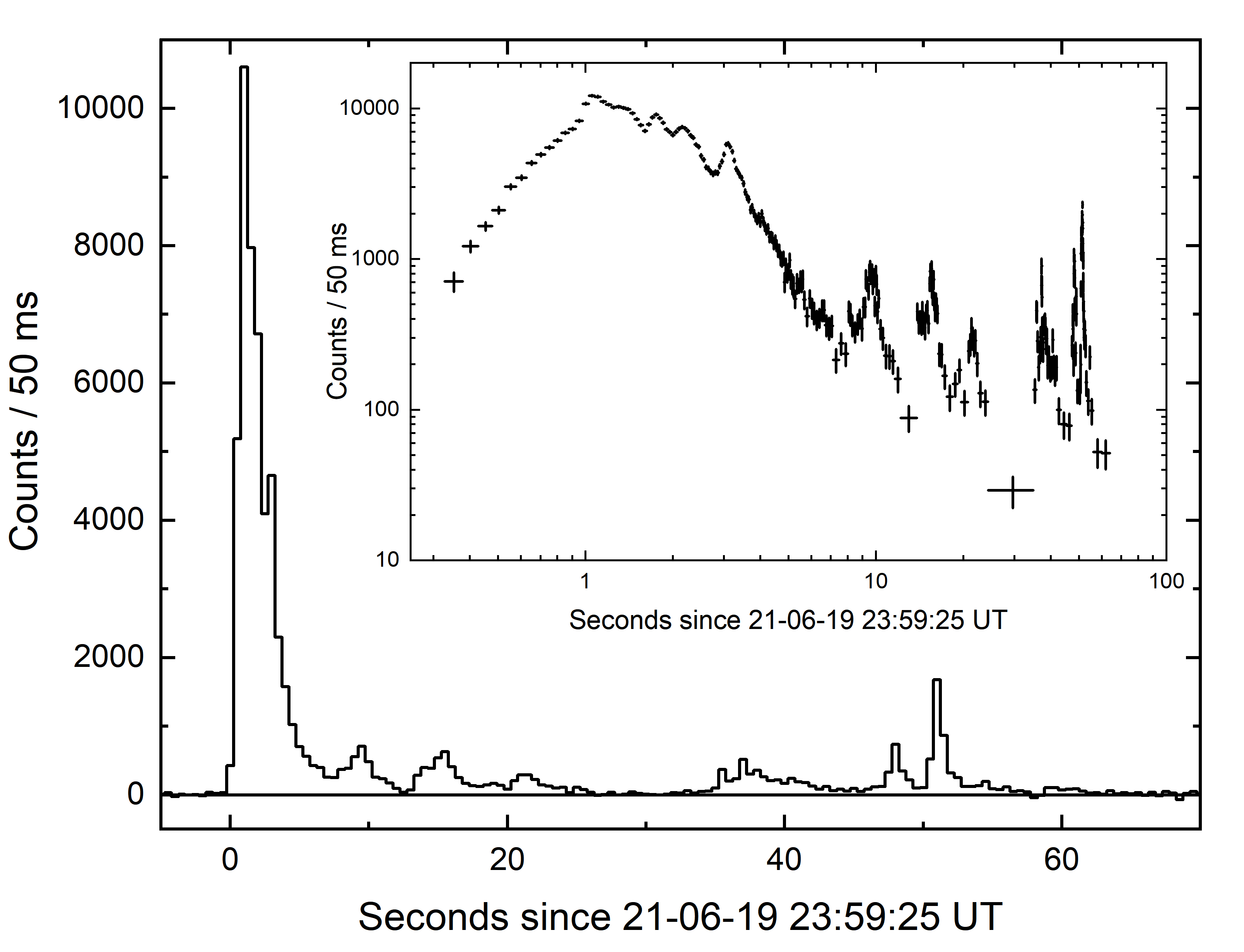
- GCN Circular #30305
Filipp D. Romanov (Russia) and David J. Lane (Saint Mary's University,
Canada) report:
Filipp Romanov observed optical afterglow of GRB 210619B (D'Avanzo et
al., GCN Circ. 30261) remotely using 0.355-m f/6.2 Schmidt-Cassegrain
telescope of Abbey Ridge Observatory (it is owned by Dave Lane) in
Canada, on 2021-06-21.
Eight images (with exposures: 660, 840, 720, 840, 720, 720, 780 and
720 seconds) were obtained with Cousins R filter from 02:29:26 to
04:56:00 UTC. The optical afterglow (with UVOT position) is clearly
(SNR = 11) visible in the stacked image (mid time = 03:42:42 UTC, that
is 1.155 days after the trigger). Romanov measured its magnitude
comparing to transformed (using formula Rc=r’-0.22 from Dymock &
Miles, 2009) r' magnitudes of nearby stars from Pan-STARRS DR1
catalogue (Chambers et al., 2016). The measured magnitude = 20.0 +/-
0.2. Magnitude was not corrected for Galactic extinction.
Stacked image available here:
http://www.abbeyridgeobservatory.ca/images/GRB210619B.jpg

- GCN Circular #30308
S.Karpov (FZU CAS, Czech Republic; SAO RAS and Kazan Federal University,
Russia)
G.Beskin (SAO RAS and Kazan Federal University, Russia),
N. Lyapsina (SAO RAS, Russia),
E.Ivanov, E.Katkova, A.Perkov (OJS RPC PSI, Russia),
A.Biryukov (SAI MSU and Kazan Federal University, Russia),
V.Sasyuk (Kazan Federal University, Russia)
Mini-MegaTORTORA nine-channel wide-field monitoring system with high
temporal resolution responded to the BAT trigger and observed the position
of GRB 210619B (D'Avanzo et al., GCN 30261) since 2021-06-20 00:00:20 UT
(T+55 s, during the ongoing gamma-ray emission) and until 2021-06-20
00:10:28 UT (T + 663 s). The system simultaneously acquired series of
frames with 1 s exposures, 5 s exposures and 30 s exposures in white light,
10 s exposures in B filter, and 10 s exposures in V filter.
The transient was clearly detectable in all acquired sequences except B
filter ones. Overall behaviour of the early light curve is consistent with
the smooth decay reported by Jelinek et al. (GCN 30263), with no
large-amplitude variability apparent in high temporal resolution data.
Mini-MegaTORTORA belongs to Kazan Federal University and is located at
Special Astrophysical Observatory near Russian 6-m telescope.
The message may be cited.
- GCN Circular #30309
A. S. Moskvitin and O. A. Maslennikova (SAO RAS),
report on behalf of the GRB follow-up team.
We observed the field of Swift GRB 210619B (D'Avanzo et al.,
GCNs #30261, #30288, #30289; Jelinek et al., GCNs #30263, #30281;
Lipunov et al., GCN #30259; Zhao et al., GCN #30261; Kong et al.,
GCN #30265; Axelsson et al., #GCN 30270; de Ugarte Postigo et al.,
GCN #30272; Zheng et al., GCN #30273; Blazek et al., GCN #30274;
Kann et al., GCN #30275; Svinkin et al., GCN #30276; Xin et al.,
GCN #30277; Perley et al., GCN #30271, Shrestha et al., GCN #30280,
Kumar et al. GCN #30286; Cunningham et al., GCN #30290; Romanov,
GCN #30291; Hu et al., GCN #30293; Zhu et al., GCN #30294;
Belkin et al., GCN #30299; Atteia, GCN #30301, Minaev et al.,
GCN #30304; Romanov & Lane, GCN #30305; Karpov et al., GCN #30308)
with the SAO RAS 1-m telescope Zeiss-1000 + CCD-photometer.
We obtained 12 x 300 sec. frames in Rc band on June 22
(22:26:19--23:45:27 UT), T_mid-T0 = 2.96283d.
The OT is clearly detected in the stacked frame with the brightness
R = 21.4 +/- 0.1 (based on nearby USNO-B1 stars).
- GCN Circular #30315
M. Marisaldi (University of Bergen), A. Mezentsev (University of Bergen),
N. Østgaard (University of Bergen), V. Reglero (University of Valencia)
and T. Neubert (DTU Space) report on behalf of the ASIM Team:
At 23:59:27.928 UT on 19 June 2021, the Atmosphere-Space Interactions Monitor (ASIM)
mission triggered on the long bright GRB 210619B
(Swift detection: D’Avanzo et al., GCN Circ. 30261; GECAM detection: Zhao et al., GCN Circ. 30264;
Fermi-LAT detection: Axelsson et al., GCN Circ. 30270; Konus-Wind detection: Svinkin et al., GCN Circ. 30276;
Fermi GBM detection: Poolakkil et al., GCN Circ. 30279; CALET detection: Kawakubo et al., GCN Circ. 30284;
SPI-ACS/INTEGRAL detection: Minaev et al., GCN Circ. 30304)
Photon by photon data with <1 microsecond time resolution have been
collected for a time interval of five seconds.
As seen by the Modular X- and Gamma-Ray Sensor (MXGS) onboard ASIM
the burst consists of a single emission episode.
The emission is detected in the MXGS High Energy Detector (HED), sensitive in the range 0.3 to >30 MeV.
The MXGS Low Energy Detector (LED), sensitive in the range 0.05 to 0.4 MeV,
was not active at trigger time.
ASIM is an ESA mission onboard the International Space Station dedicated to the
observation of Terrestrial Gamma-ray Flashes (TGFs) and Transient Luminous Events (TLEs)
operative since June 2018 (Neubert et al., Space Sci Rev (2019) 215:26
https://doi.org/10.1007/s11214-019-0592-z ).
The payload includes the Modular X- and Gamma-Ray Sensor (MXGS)
(Østgaard et al., Space Sci Rev (2019) 215:23 https://doi.org/10.1007/s11214-018-0573-7 ),
and the the Modular Multispectral Imaging Array (MMIA)
(Chanrion et al., Space Sci Rev (2019) 215:28 https://doi.org/10.1007/s11214-019-0593-y ).
The ASIM Science Data Centre (ASDC) website is https://asdc.space.dtu.dk/
- GCN Circular #30320
J. Vinko, L. Kriskovics, A. Pal, R. Szakats, K. Vida, Zs. Szabo, R. Konyves-Toth, M. Krezinger and K. Sarneczky (Konkoly Observatory, Hungary) report:
We observed the field of GRB210619B
(D'Avanzo et al.,GCN #30261, #30288, #30289; Jelinek et al., GCN #30263, #30281;
Lipunov et al., GCN #30259; Zhao et al., GCN #30261; Kong et al.,
GCN #30265; Axelsson et al., #GCN 30270; de Ugarte Postigo et al.,
GCN #30272; Zheng et al., GCN #30273; Blazek et al., GCN #30274;
Kann et al., GCN #30275; Svinkin et al., GCN #30276; Xin et al.,
GCN #30277; Perley et al., GCN #30271, Shrestha et al., GCN #30280,
Kumar et al. GCN #30286; Cunningham et al., GCN #30290; Romanov,
GCN #30291; Hu et al., GCN #30293; Zhu et al., GCN #30294;
Belkin et al., GCN #30299; Atteia, GCN #30301, Minaev et al.,
GCN #30304; Romanov & Lane, GCN #30305; Karpov et al., GCN #30308;
Moskvitin & Maslennikova, GCN #30309; Marisaldi et al., GCN #30315)
with the RC80 robotic telescope at Piszkesteto Station of Konkoly
Observatory on 2021 June 22 starting at 22:46:41.5 UT. A series of 5x300 sec
frames were collected through Sloan r'- and i' bands. The optical afterglow
was detected with the following magnitudes calibrated via nearby PS1 stars:
Date UT-middle t-T0(hr) Exp(s) r'(mag) i'(mag)
2021-06-22 23:07:16 71.13 5x300 21.454 +/-0.333 20.089 +/-0.280
Follow-up observations on 2021-06-23 starting at 21:34:37.7 UT (3.90 days post-trigger)
resulted in no detection down to limiting magnitudes of r'=22.14 and i'=21.98 mag.
- GCN Circular #30338
D. A. Kann (HETH/IAA-CSIC), A. de Ugarte Postigo (HETH/IAA-CSIC,
DARK/NBI), M. Jelinek (ASU CAS Ondrejov), M. Blazek, C. Thoene, J. F.
Agui Fernandez (all HETH/IAA-CSIC), and P. Minguez (CAHA) report:
We re-observed the afterglow of GRB 210619B (D'Avanzo et al., GCN
#30261) with CAFOS mounted at the 2.2m Calar Alto telescope (Almeria,
Spain). Image depth was influenced by moonlight but conditions were
good. We obtained 20 x 180 s images in r'.
The afterglow is faintly detected in the stacked image. Against
Pan-STARRS comparison stars, we derive r' = 22.56 +/- 0.16 mag at
6.12346 d after the trigger.
Using selected data from GCN Circulars (Jelinek et al., GCN #30263,
#30281; Pellegrin et al., GCN #30268; Perley, GCN #30271; Zheng &
Filippenko, GCN #30273; Blazek et al., GCN #30274; Kann et al., GCN
#30275; Xin et al., GCN #30277; D'Avanzo et al., GCN #30288; Moskvitin &
Maslennikova, GCNs #303291, #30303, #30309; Romanov, GCN #30292; Hu et
al., GCN #30293; Zhu et al., GCN #30294; Belkin et al., GCN #30299;
Romanov & Lane, GCN #30305; Vinko et al., GCN #30320), we find the
afterglow after 0.057 d can be fit by a smoothly broken power-law with a
sharp break and parameters alpha_1 = 0.742 +/- 0.013, alpha_2 = 1.221
+/- 0.045, and break time t_b = 0.465 +/- 0.048 d (40136 +/- 4108 s).
This fully confirms the steepening decay reported by Jelinek et al., GCN
#30281; Kumar et al., GCN #30286.
Note that the best fit of the X-ray light curve at the time finds
alpha_1 = 0.978 +0.012 -0.019, alpha_2 = 1.50 +/- 0.035, t_b = 0.152
+0.015 -0.024 d (13100 +1300 -2100 s). However, the early decay (alpha_0
= 0.773 +0.087 -0.141, up to 500 s) is very similar to the optical decay
we find from ~5000 s onward to the (optical) break. We note that the
post-break decay slope would be extremely shallow if this were actually
a jet break, but no deviation from this decay is seen until ~6 d.
- GCN Circular #30343
I. Zaznobin, R. Burenin, A. Lutovinov (IKI),
E. Klunko, M. Eselevich (ISTP SB RAS)
report:
The field of GRB 210619B detected by Swift (D'Avanzo et al. GCN
30261), GECAM (Zhao et al. GCN 30264), CALET (Kawakubo et al. GCNC
30284), SRG/ART-XC (Levin et al. GCNC 30283), Fermi-LAT (Axelsson et
al. GCNC 30270), Konus-Wind (Svinkin et al. GCN 30276) and Fermi/GBM
(Poolakkil et al. GCNC 30279) was observed with the Sayan observatory
1.6-m telescope AZT-33IK, using a CCD photometer, starting at
2021/06/20 17:58 UT, i.e. approximately 18 hours after the burst.
We obtained 12x60 s images in each g,r,i,z SDSS filter. The OT is
clearly detected in every frame, with the following magnitudes:
g = 20.26 +- 0.06
r = 19.51 +- 0.08
i = 19.08 +- 0.06
z = 18.69 +- 0.07
- GCN Circular #30361
I.A. Smith (Rice U.), D.A. Perley (LJMU), and N.R. Tanvir
(U. of Leicester) report:
We observed the Swift UVOT location of GRB 210619B (D'Avanzo
et al., GCN Circ. 30261) using the SCUBA-2 sub-millimeter
continuum camera on the James Clerk Maxwell Telescope.
Observations totaling 2.1 hours were obtained on UT 2021-06-20 and
2021-06-21 in average and poor weather conditions respectively.
No counterpart was detected in the individual or combined maps.
Combining all the data, the RMS background noise was 1.61 mJy/beam
at 850 microns and 27.9 mJy/beam at 450 microns; the mid-point of
the run was 1.07 days after the burst trigger.
We thank Patrice Smith, Mark Rawlings, Harriet Parsons, and the
JCMT staff for the prompt support of these observations that were
taken under project M21AP020.
- GCN Circular #30386
T. Laskar (University of Bath), K. D. Alexander (Northwestern), E. Berger
(Harvard), W. Fong (Northwestern), R. Margutti (Northwestern), C. G.
Mundell (University of Bath), and P. Schady (University of Bath) report on
behalf of a larger collaboration:
"We observed GRB 210619B (D'Avanzo et al. GCN 30261) with the Atacama Large
Millimeter/Submillimeter Array (ALMA) at 97.5 GHz beginning on 2021 June 25
06:53:48 UT (5.29 days after the burst). ALMA observations of this burst
were delayed due to a major snowstorm at the array.
Preliminary analysis reveals a mm source with flux density of ~ 0.1 mJy at
position:
RA (J2000) = 21:18:52.349 (+/- 0.002)
Dec (J2000) = +33:51:01.40 (+/- 0.04)
consistent with the X-ray position (Beardmore et al. GCN 30267) and optical
position (D'Avanzo et al., GCN 30261; Kuin et al. GCN 30278).
We thank the JAO staff, AoD, P2G, and the entire ALMA team for their help
with these observations."
- GCN Circular #30791
S. Belkin (IKI), A. Pozanenko (IKI), O. Burhonov (UBAI), V. Kim (FAI,
HSE), M. Krugov (FAI), N. Pankov (HSE), Sh. Ehgamberdiev (UBAI), report
on behalf of IKI-GRB-FuN:
We observed the field of GRB 210619B (D'Avanzo et al. GCN 30261) with
AZT-22 telescope of Maidanak Observatory and AZT-20 telescope of
Assy-Turgen observatory. The optical afterglow (D'Avanzo et al. GCN
30261; Jelinek et al., GCN 30263; Kong, GCN 30265; Pellegrin et al., GCN
30268; Perley, GCN 30271; Zheng and Filippenko, GCN 30273; Blazek et
al., GCN 30274; Kann et al., GCN 30275; Xin et al., GCN 30277; Kiun et
al., GCN 30278; Shrestha et al., GCN 30280; Jelkinek et al., GCN 30281;
Kumar et al., GCN 30286; D'Avanzo et al., GCN 30288; Moskvitin and
Maslennikova, GCN 303291; Romanov, GCN 30292; Hu et al., GCN 30293; Zhu
et al., GCN 30294; Belkin et al., GCN 30299; Moskvitin and Maslennikova,
GCN 30303; Romanov and Lane, GCN 30305; Moskvitin and Maslennikova, GCN
30309; Vinko et al., GCN 30320; Kann et al., GCN 30338; Zaznobin et al.,
GCN 30343) is clearly detected on the most of stacked images.
Preliminary photometry of the afterglow of some of observations is
following.
Date UT start t-T0 Filter Exp. OT UL(3sigma) Telescope
(mid, days) (s)
2021-06-20 19:02:53 0.79963 R 8*300 19.47 0.06 23.0 AZT-22
2021-06-21 19:53:41 1.85019 R 12*300 20.43 0.05 23.2 AZT-22
2021-06-22 17:15:29 2.74206 r 75*60 21.82 0.26 22.6 AZT-20
2021-06-22 18:35:45 2.79606 R 12*300 21.21 0.09 23.1 AZT-22
2021-06-26 20:15:18 6.86520 R 20*180 22.55 0.24 23.2 AZT-22
2021-07-02 20:16:53 12.86630 R 12*300 23.5 0.3 23.5 AZT-22
2021-07-08 19:16:40 18.83003 r 76*60 n/d n/d 23.2 AZT-20
2021-07-18 19:50:46 28.84816 R 12*300 n/d n/d 23.9 AZT-22
Photometry is based on the USNO-B1.0 and PanSTARRS-PS1 nearby stars.
USNO-B1.0_id R2 I
1238-0493928 15.08 14.33
1238-0494511 15.67 15.03
1238-0493842 17.53 17.36
1238-0493787 16.81 16.12
PanSTARRS-PS1
RA DEC r
21:18:52.24182 +33:49:14.6348 15.2925
21:18:45.71408 +33:50:40.3319 18.1642
Using our data and those published in the GCN circulars cited above we
plot a light curve which an be found at
http://grb.rssi.ru/GRB210619B/GRB210619B_LC_all.png
Using only Maidanak data after 0.7 days, it was found that the light
curve can be fitted by a single power law with the index alpha = -1.48
+/-0.04. Using early data published in GCNs we can describe the LC by a
broken power law with parameters of alpha = -0.72+/-0.01, beta = -1.52
+/-0.04, and break time of 0.57+/-0.12.
The fitted LC can be found at
http://grb.rssi.ru/GRB210619B/GRB210619B_AZT22_LC.png
It confirms the steeping decay suggested by Jelinek et al., GCN 30281,
Kumar et al., GCN 30286. The power-law index before the break is
approximately the same as that obtained by Kann et al., GCN 30338 and
Oganesyan et al., arXiv:2109.00010, while the power law index after the
break is steeper and coincides with XRT afterglow power law index.
We also not detected any influence of host galaxy on afterglow light
curve, and after late time observations we can estimate brightness of
the host galaxy R > 23.9.
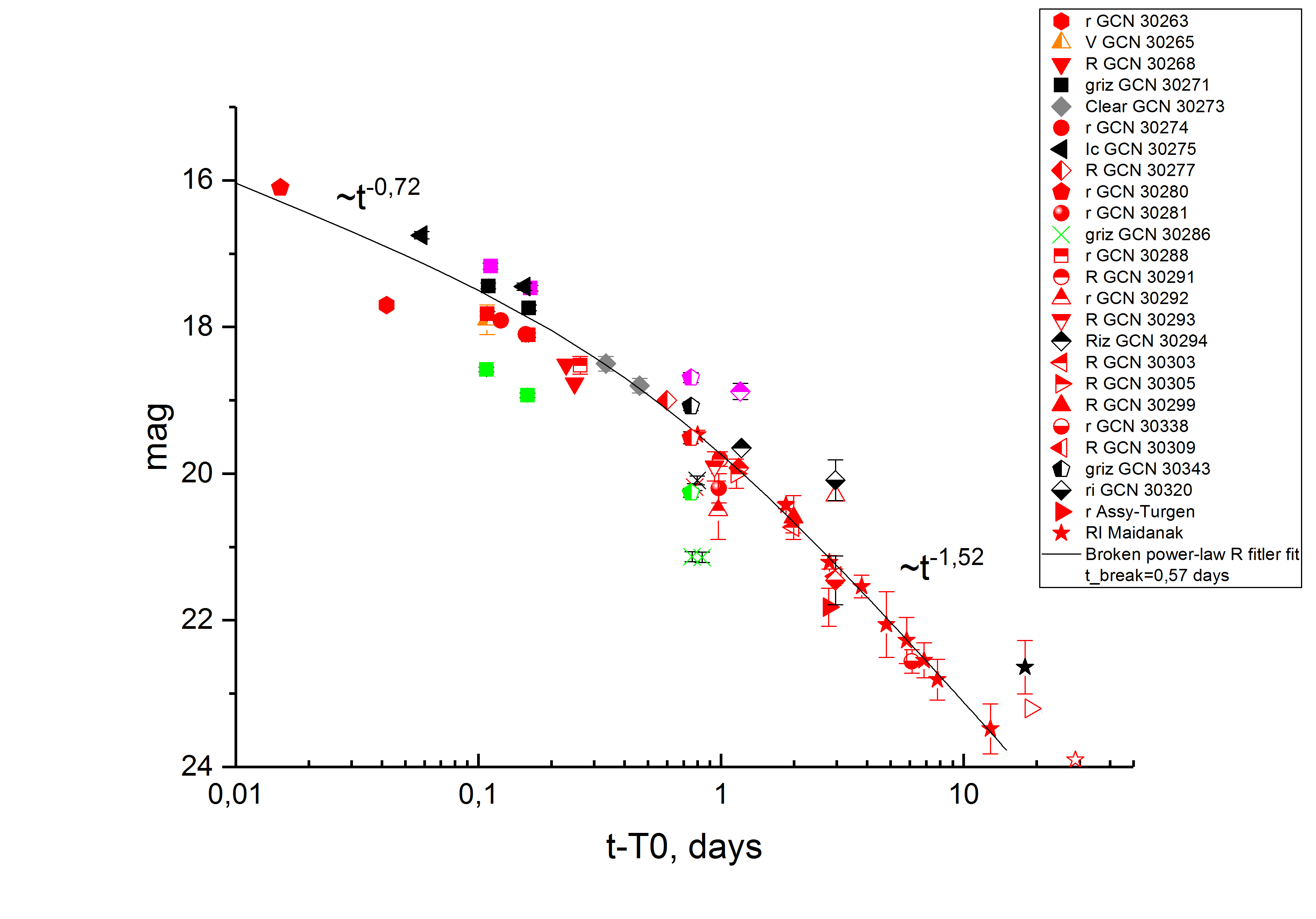
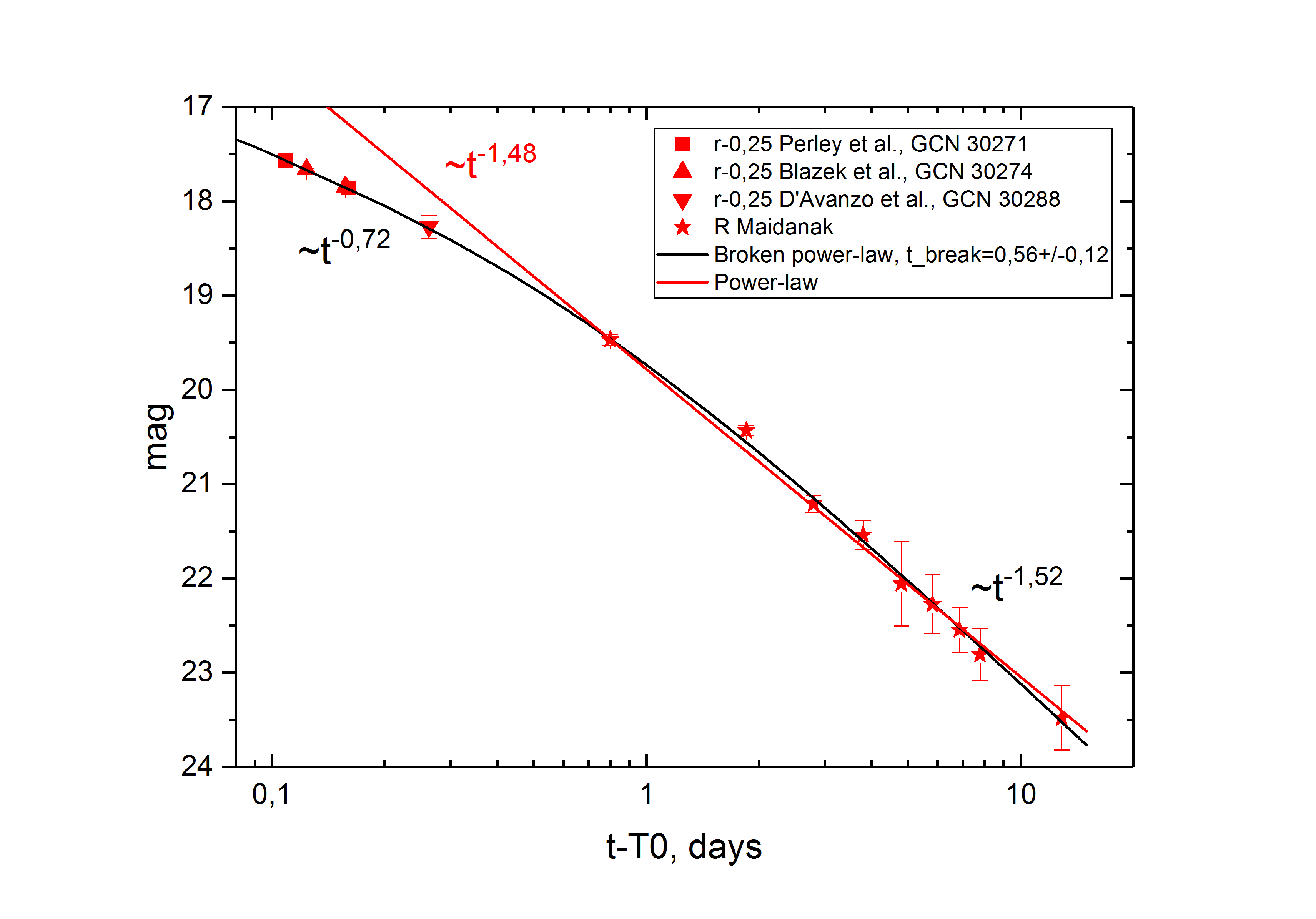
![]() Previous IAU Circulars
Previous IAU Circulars 


















